We have blogged about open air markets in multiple countries and have commented on how valuable a window into the local culture, open markets typically are.
Unlike tourists destinations, be they cultural destinations that are packaged/curated to appeal to travelers and tourists, markets are always the real thing!
Most capital cities have large markets, but in the West, they have tended to disappear – a good example of that is the large fruit and vegetable meat market in Paris, Les Halles, which a couple of decades back was deemed “unsanitary” because of the rodents it inevitably attracted in the center of Paris.
For people who love open air real markets like ourselves, it is a treat to go to such a huge expansive market and spend a few hours discovering the variety of plentiful produce and watch the vendors and buyers interacting. Colombo’s large and historic Pettah market is open every single day and has been in operation going back as far as anyone can remember…
The main reason we are here today is to buy raw cashew and almond nuts in bulk. It is nice to have a particular goal, but as well we find all sorts of seasonal fruits and unusual local greens and vegetables.
When Colombo became the capital during British rule after 1815, Colombo Port became the main hub for trade in the Indian ocean. Traders from both East and West called on the port and the Pettah market became a convenient trading place for all the goods that transited through Sri Lanka. The Moors were avid traders and to this day, the Pettah neighborhood is primarily Muslim. The “Red Mosque”, officially named Jami Ul-Alfar Mosque is a central building in the neighborhood, nearby the fruit market and is one of the oldest Mosques in all of Sri Lanka. The call to prayer resonates 5 times a day as one goes about the Pettah food market.
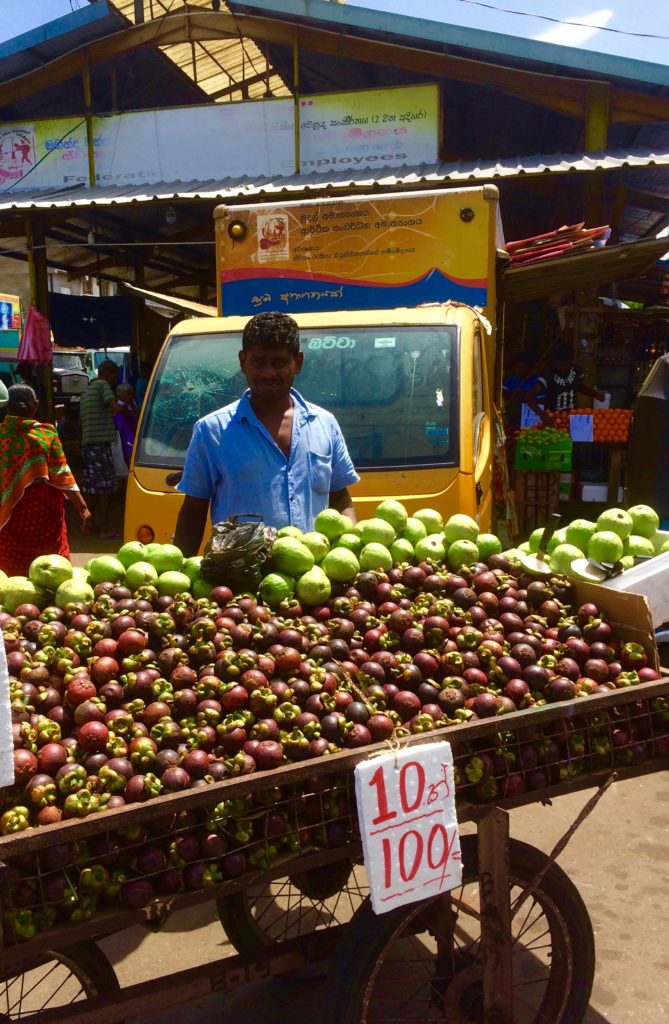
It’s MANGOSTEEN season in Sri Lanka! One of our favorite tropical fruits, which we first tried in Viet Nam. The sweet white fleshy segments are covered by a hard aubergine colored skin.
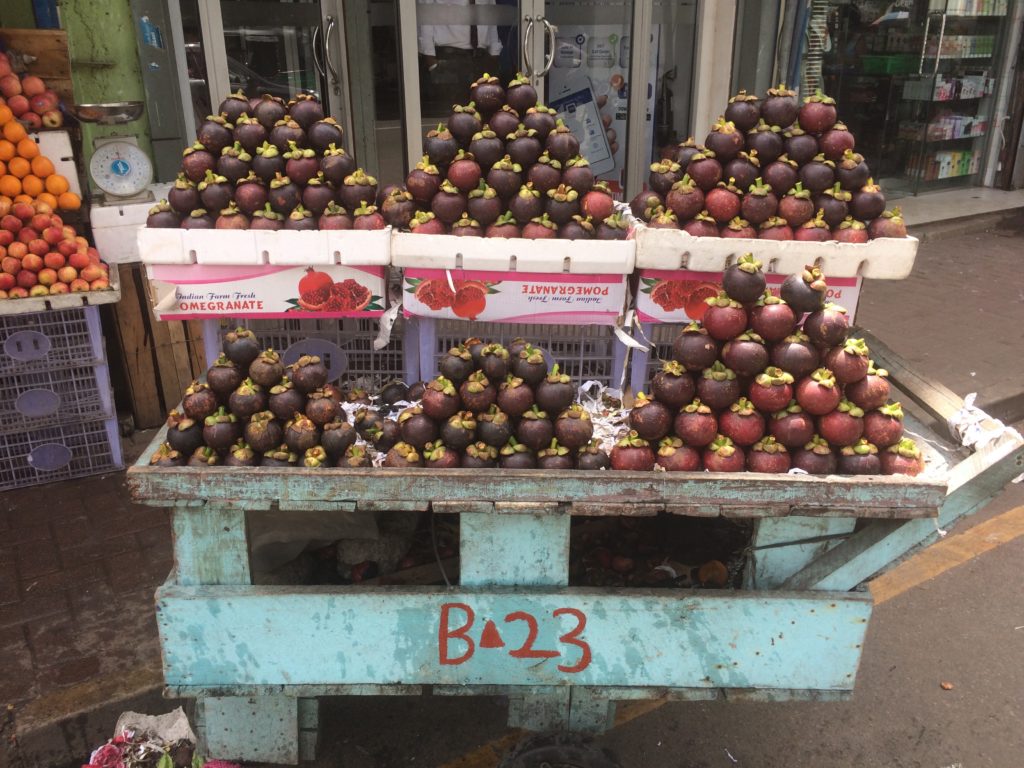
Piles of mangosteen everywhere!
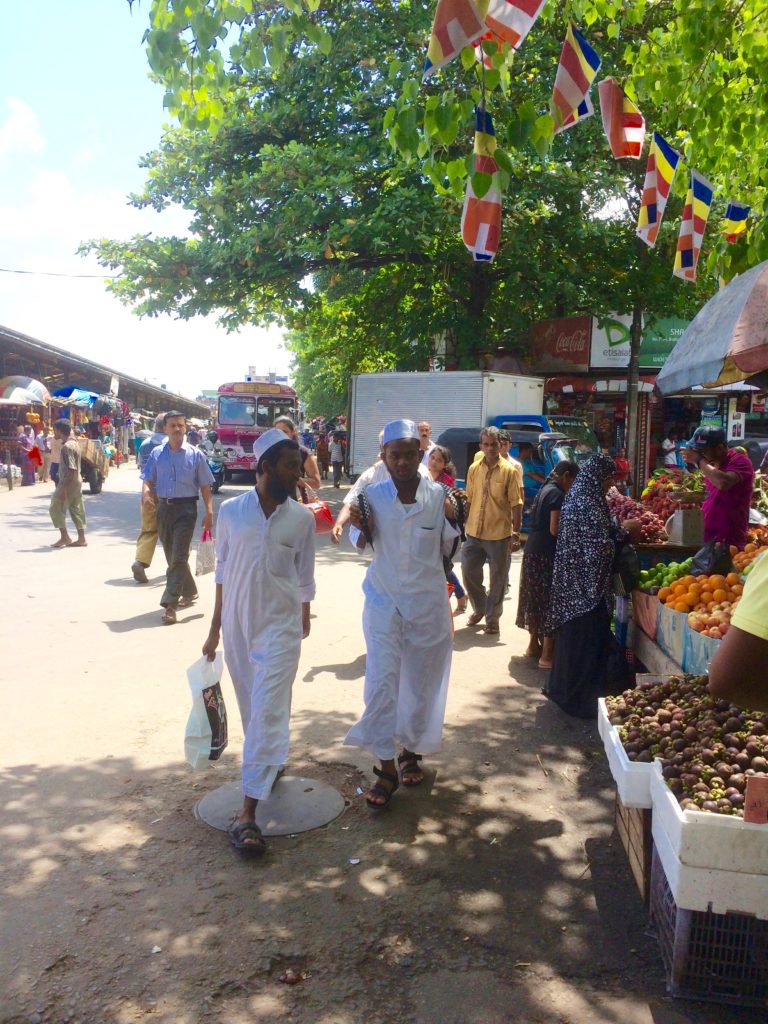
The predominantly Muslim Pettah neighborhood is reflected in the typical long white dress worn by Muslim men.
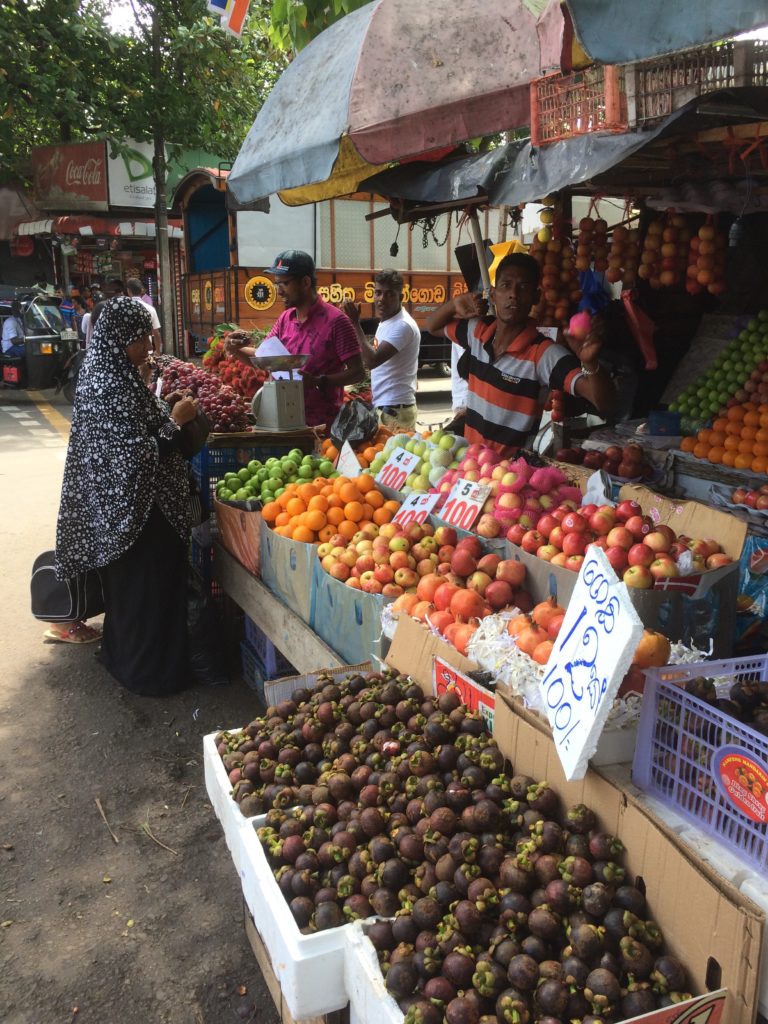
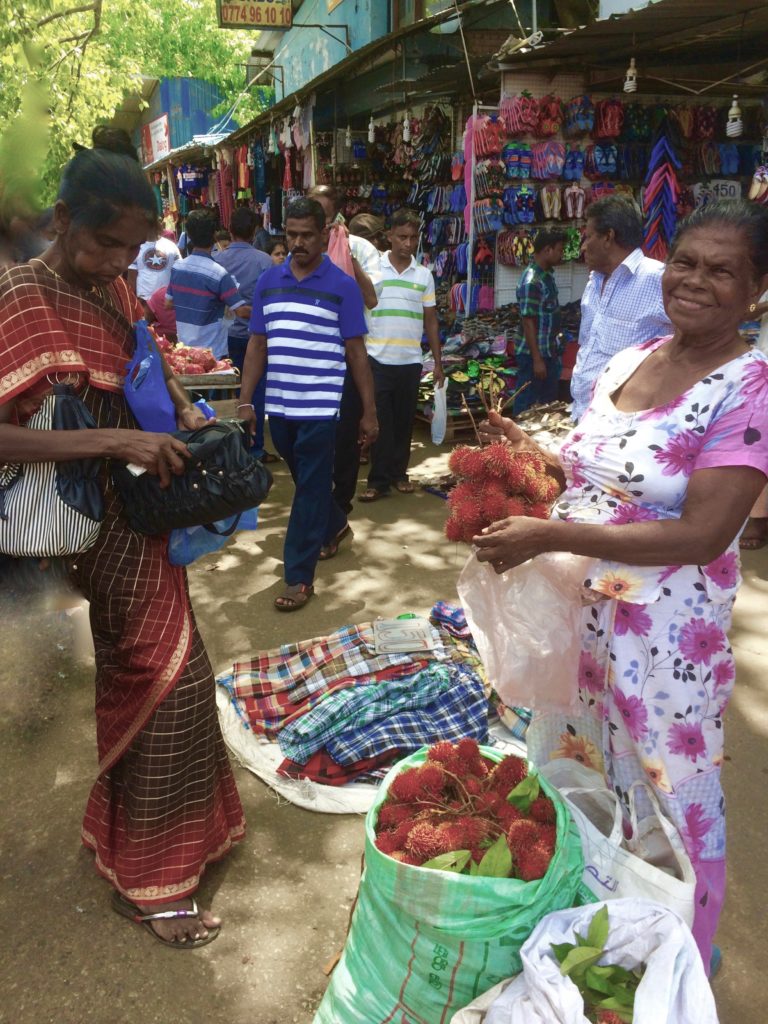
Rambutan fruit is another favorite of ours, also currently in season, and luckily the season seems to be a fairly long one. One can buy the rambutan by the kilo, but it is priced per unit at 10 rupees, which is 7 cents a fruit. The woman in her wine colored sari, is trying out the vendor’s rambutan, you can see the fruit tucked into her cheedk!
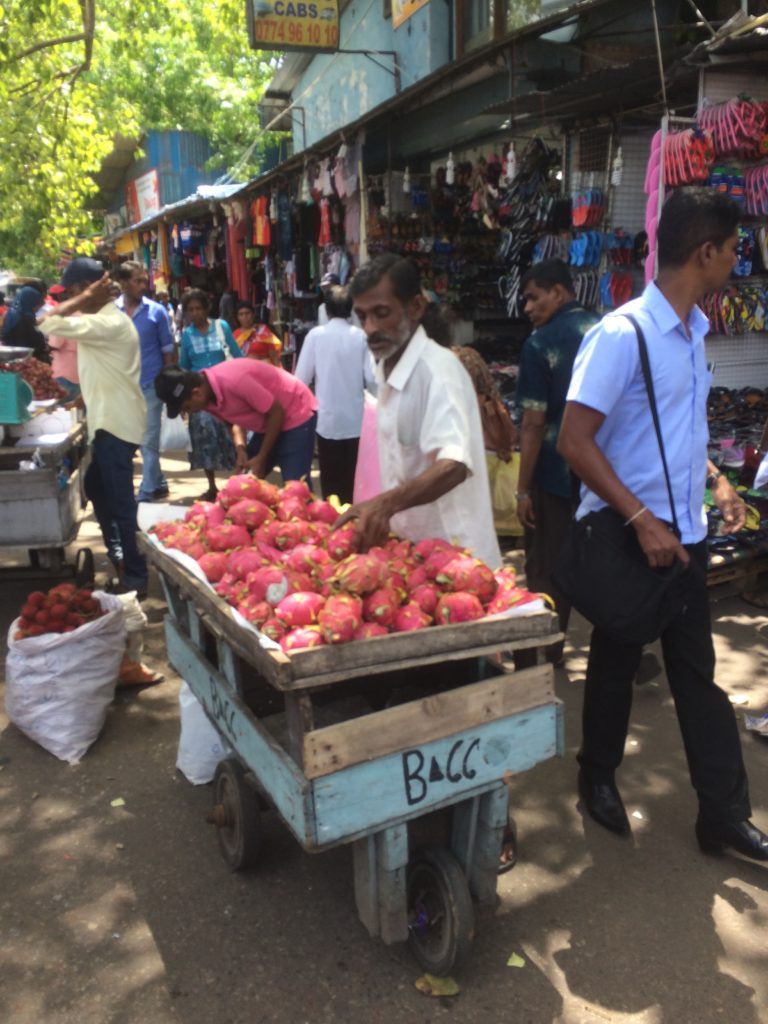
Dragon fruit is the fruit from the cactus tree, indigenous to the Americas but the climate in South Asia has proven fertile for its growth. The outside of this fruit is a bright fuschia pink and in some varieties the interior is the same color yet even brighter. However, so far the only ones we have seen in Sri Lanka have a white interior. They are rich in vitamin C, full of antioxidants and are good for decreasing bad cholesterol levels. And they are sweet and delicious too.
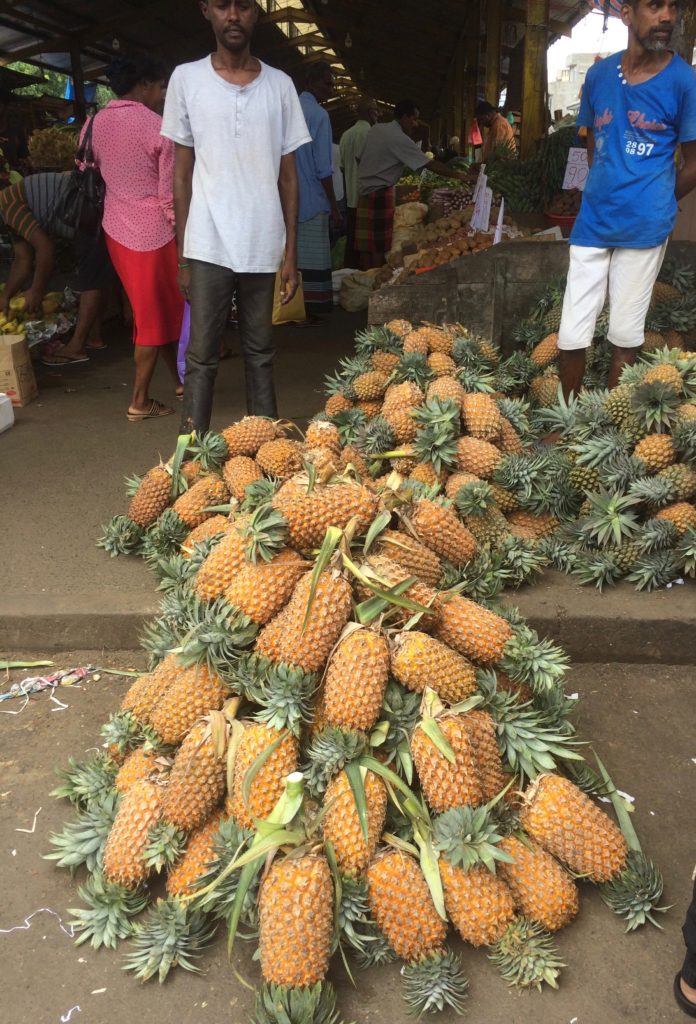
A heap of orange pineapples literally spilling out onto the street.
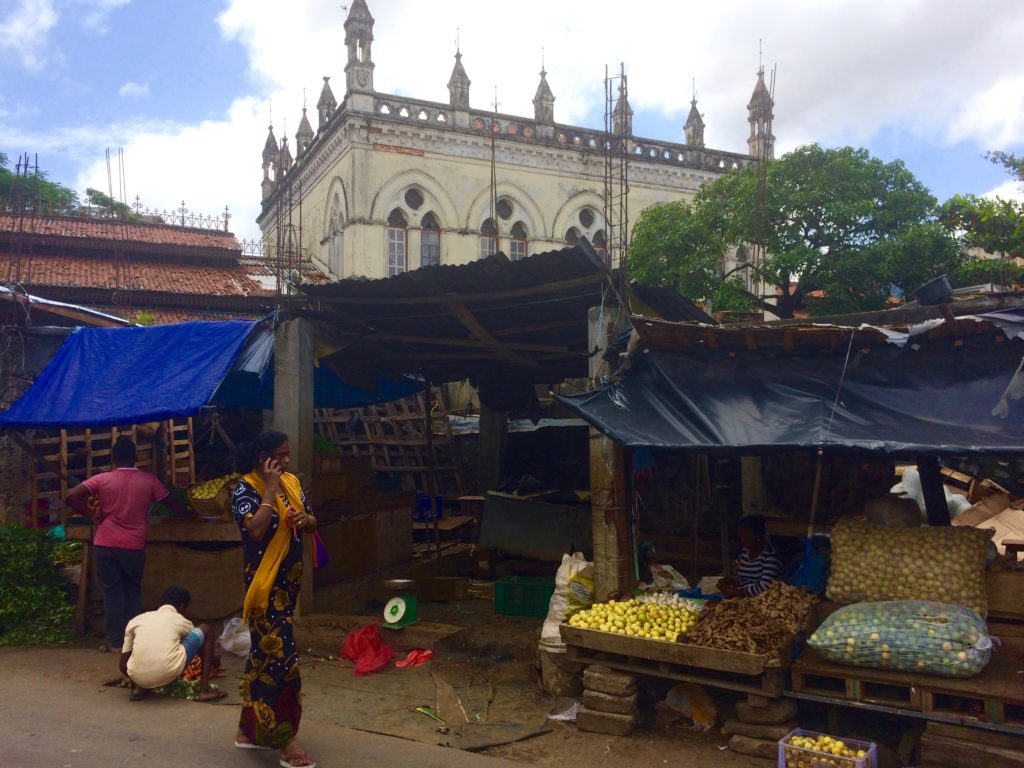
At certain points of the market, the contrast between the gothic architecture and the street level stalls is eye catching.
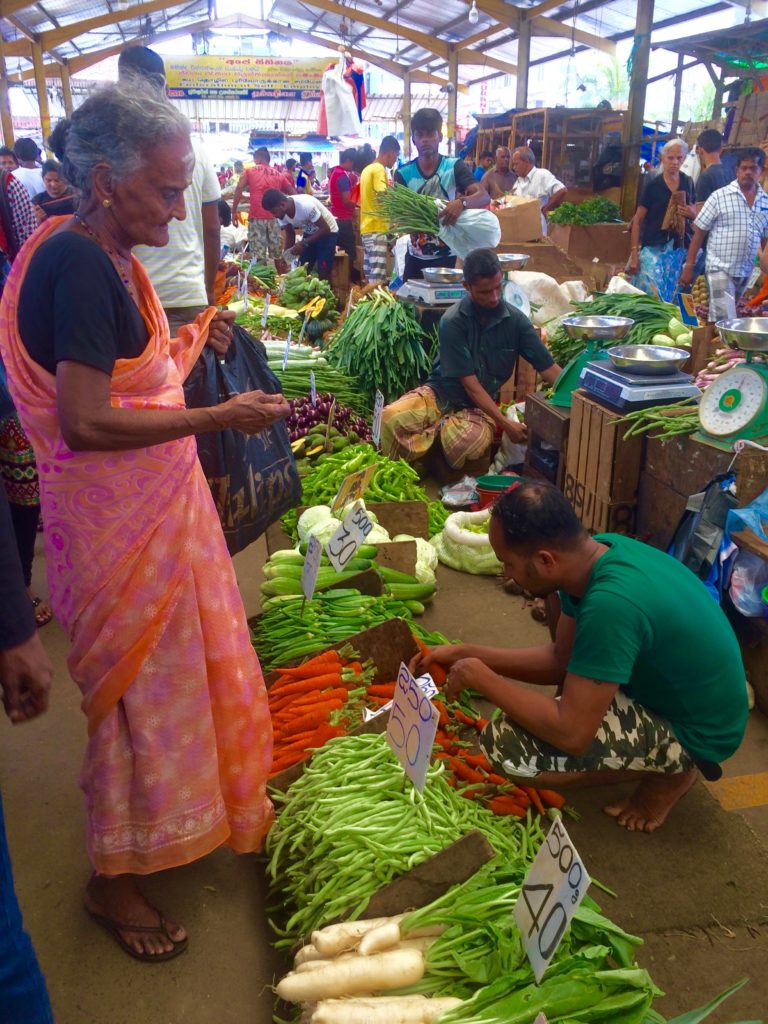
One section of the market is covered and here a Tamil woman is carefully getting the vendor to choose the best carrots for her.
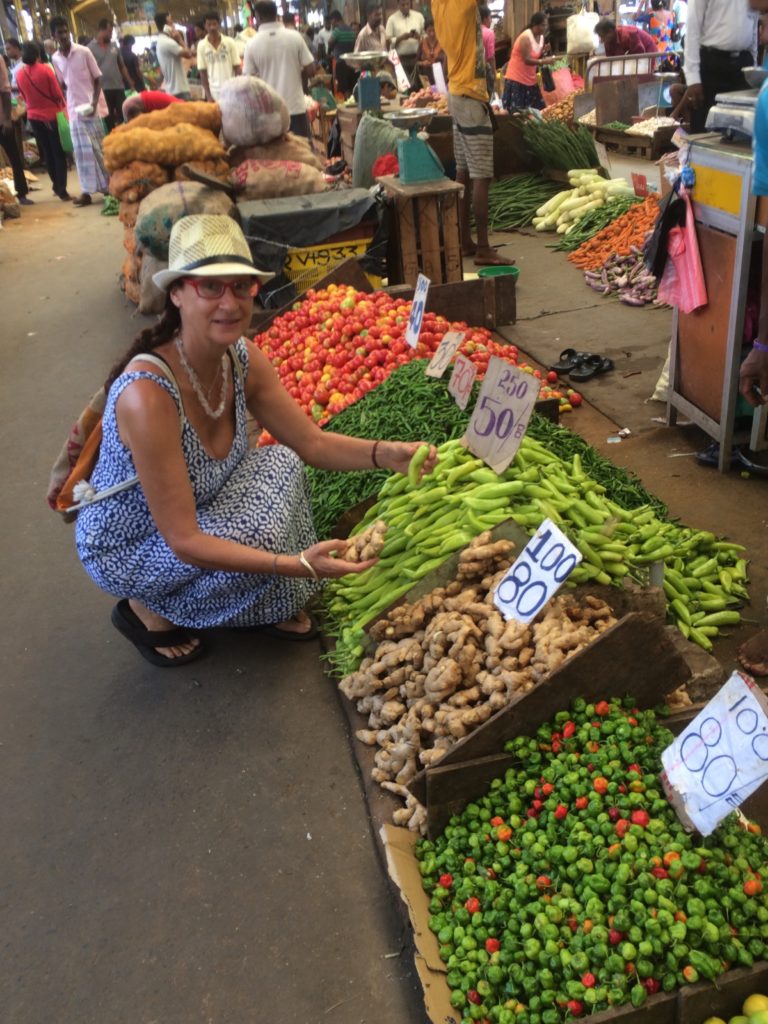
Peta in Pettah market… in her element. Fresh ginger and jalapeno peppers feature predominantly in many raw vegan dishes, providing the heat to the dish.
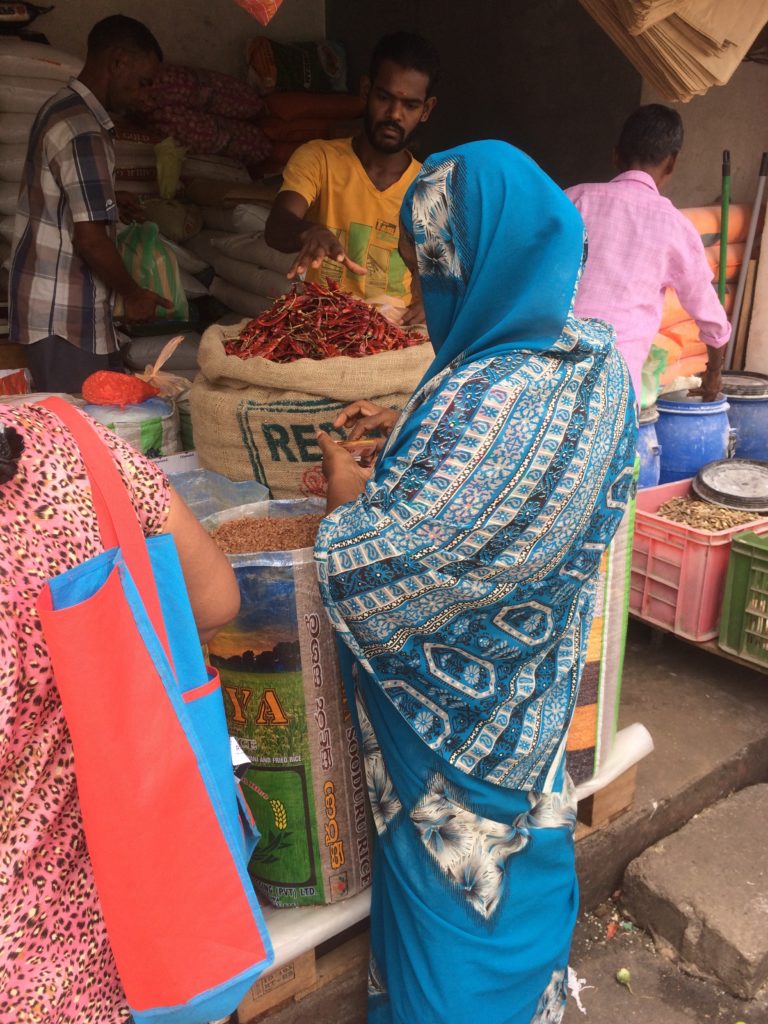
The market is a kaleidoscope of colors. Saris contrast against bright chili peppers and other vegetables.
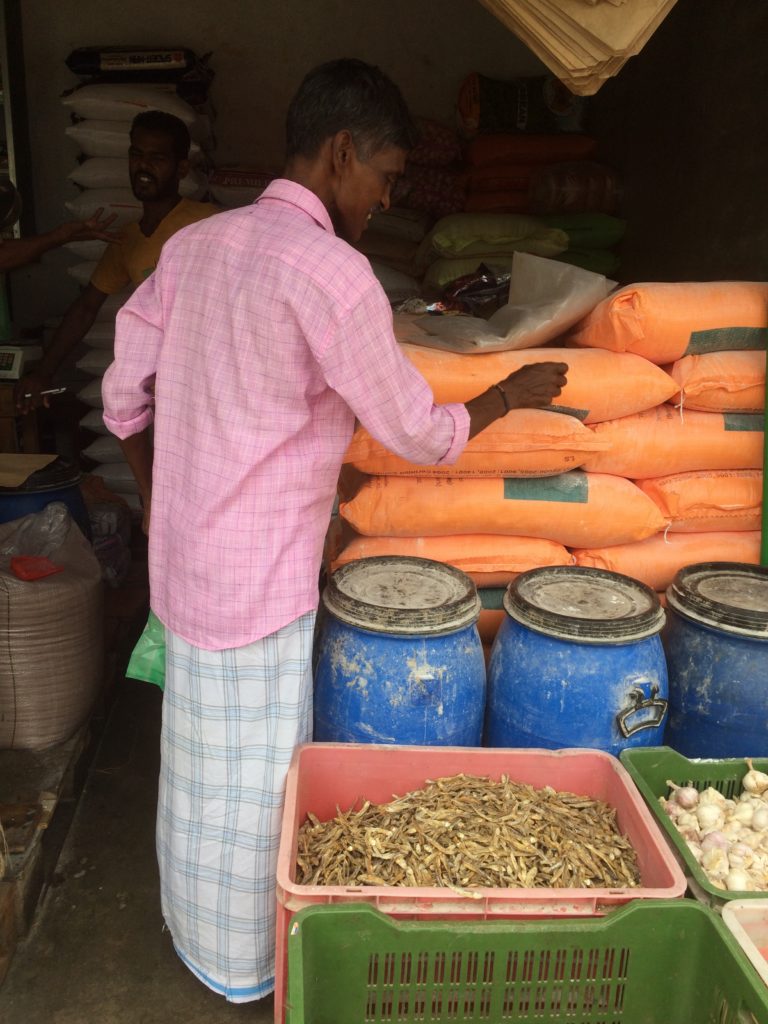
Pastel colored sarong against orange bags of rice and bright blue containers.
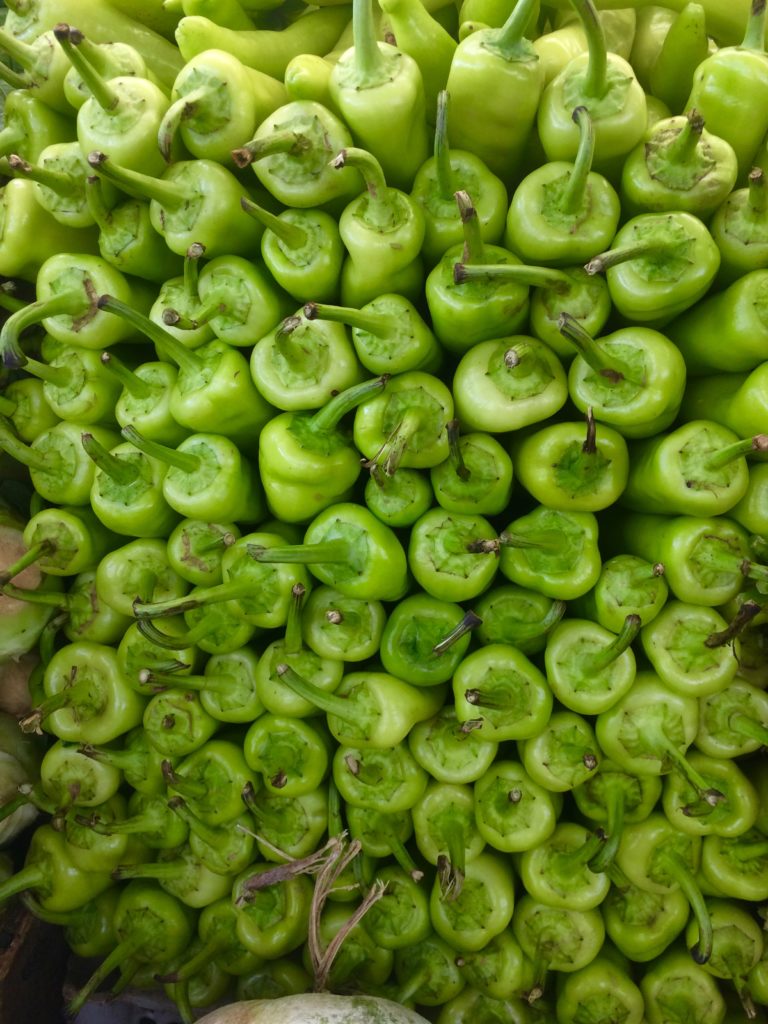
Graphic art is everywhere….. Jalapeno installation.
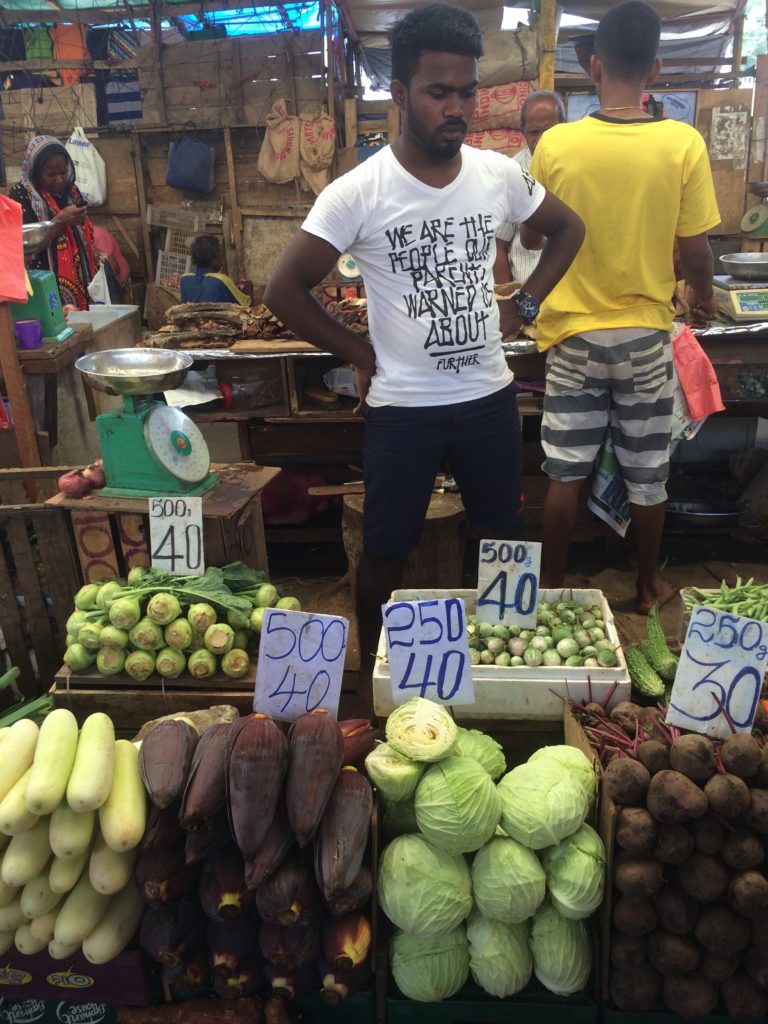
Many young Sri Lankan men prefer modern clothing especially those that live in the big cities, over the classic sarong. “We are the people our parents warned us about”… funny. In front, you can see purple banana flower pods for sale, second from the left, and used in curries.
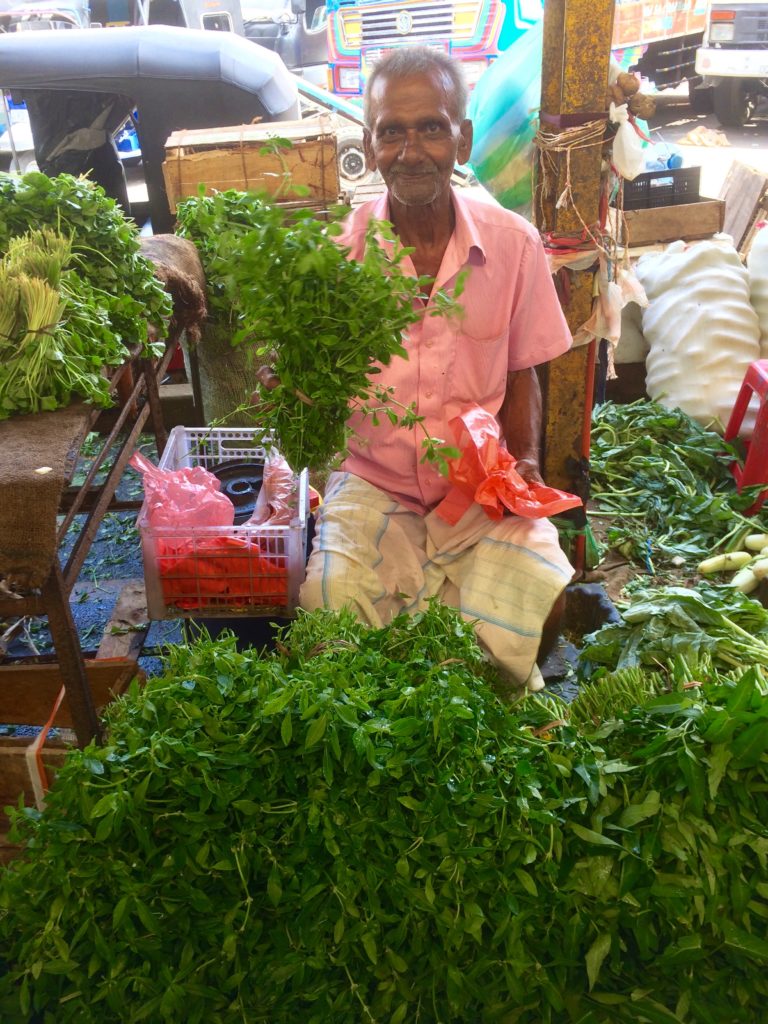
A vendor, very proud of his homegrown herbs and greens. Many of these leaves are used to flavor curries.
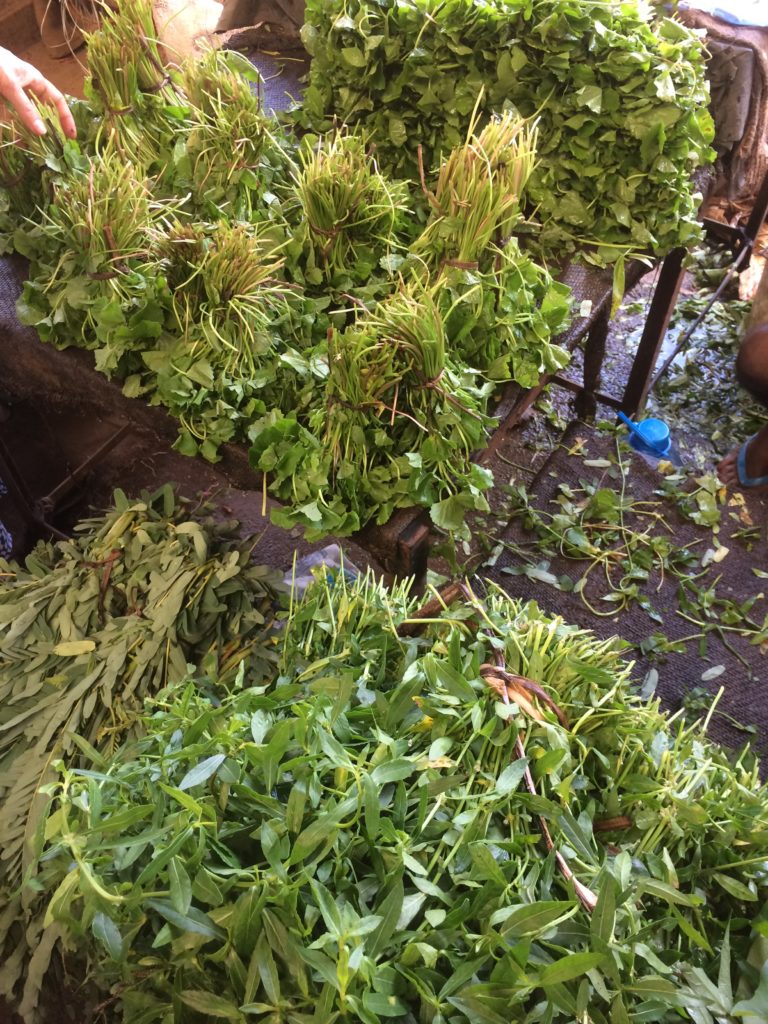
The “gotukola” at the top (pennywort) has many medicinal properties and as well makes a delicious dark green hot soup, which tastes similar to a French watercress soup (says Ben).

We have some gottukola growing at our house but still in small quantities. It is a great green to use in juices or green smoothies.
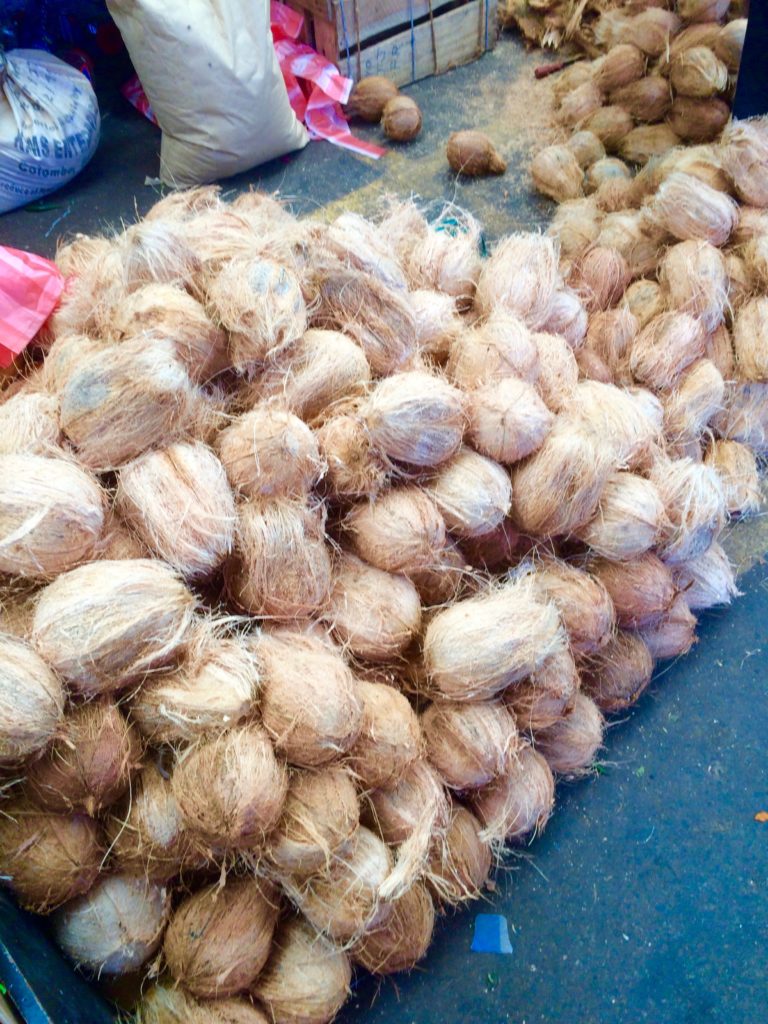
Coconuts are omnipresent in Sri Lanka. There are a few varieties and they are used extensively in the local cuisine. These “hairy” coconuts not only provide delicious thick white “meat” but the husks are broken down to make the strongest of ropes.
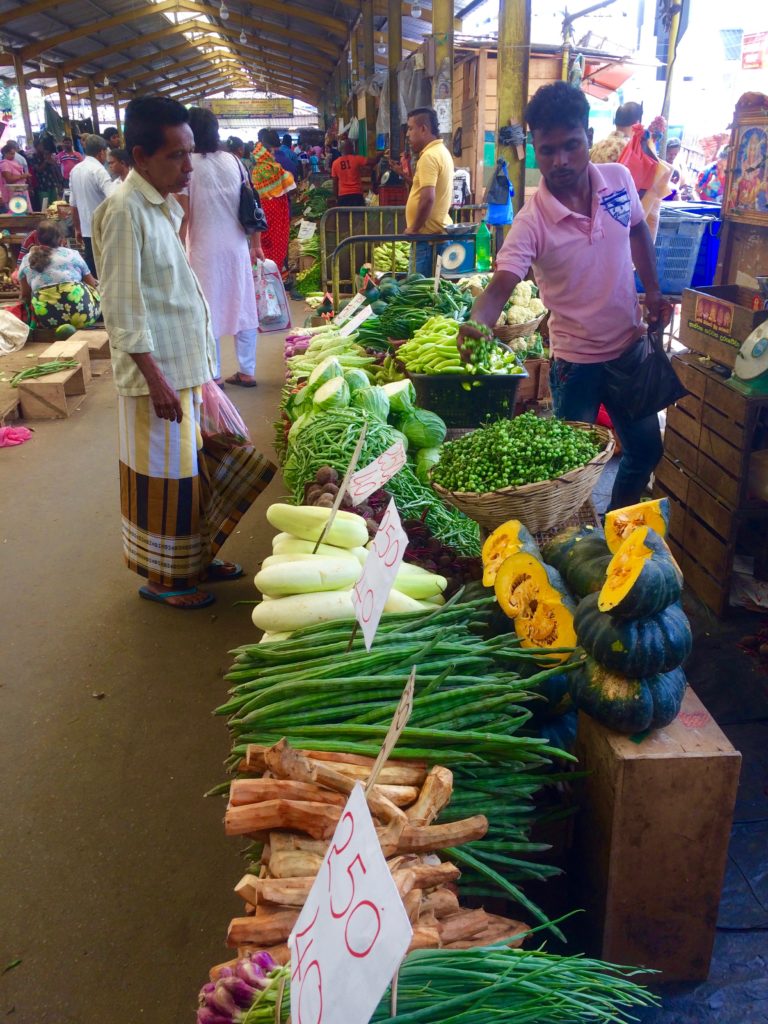
One of the things that always fascinate us the world over about markets, are how the vegetables are presented, piled up, displayed, featured…..
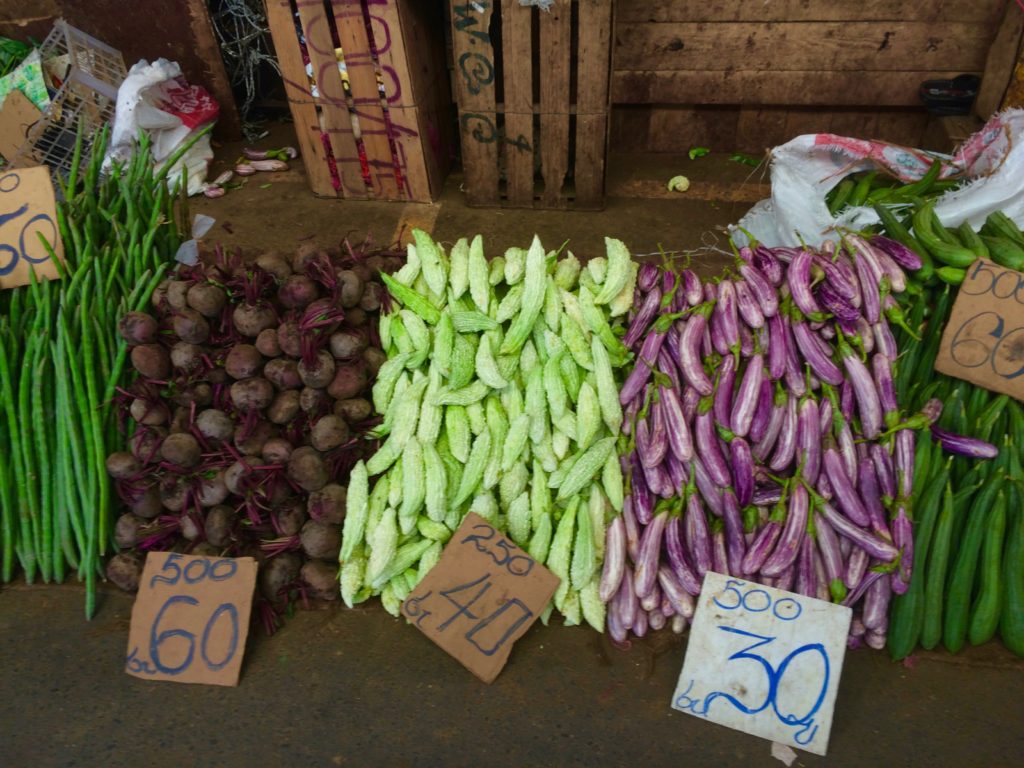
Shades of purples and greens… A type of green beans, beetroot, bitter melon, aubergine and okra.
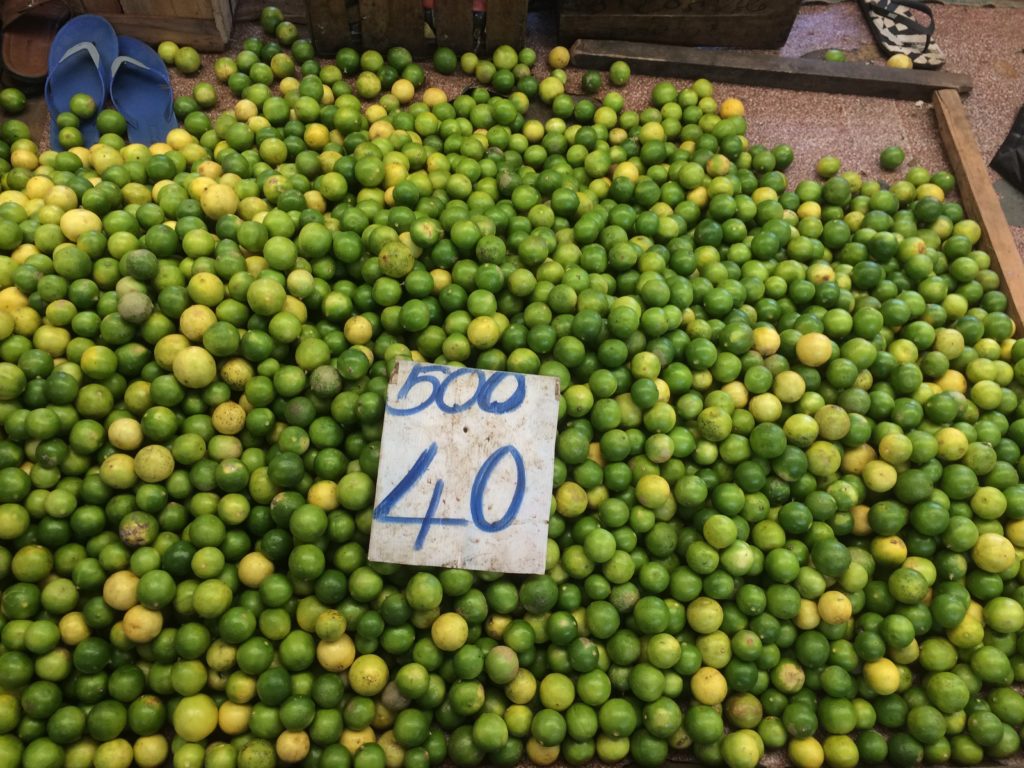
We go through SO many limes and/or lemons… We start our day with a glass of lemon water, as this provides a natural flush for the digestive system and rehydrate the body after hours of sleep. Having a does of vitamin C first thing in the morning, also gives the body an immune boost. So we always buy fresh lemons. in abundance. We have two small lemon trees but nowhere near fruit bearing yet.

Crates of dried fish of every variety from sardines, to anchovies to squid. These are used to flavor soups, stews and curries. Being an island surrounded by the Indian Ocean, Sri Lanka has a remarkable fish industry but fish deteriorate fast so people use different methods to preserve fresh fish. Sun drying salted fish is one of the common methods used in Sri Lanka.
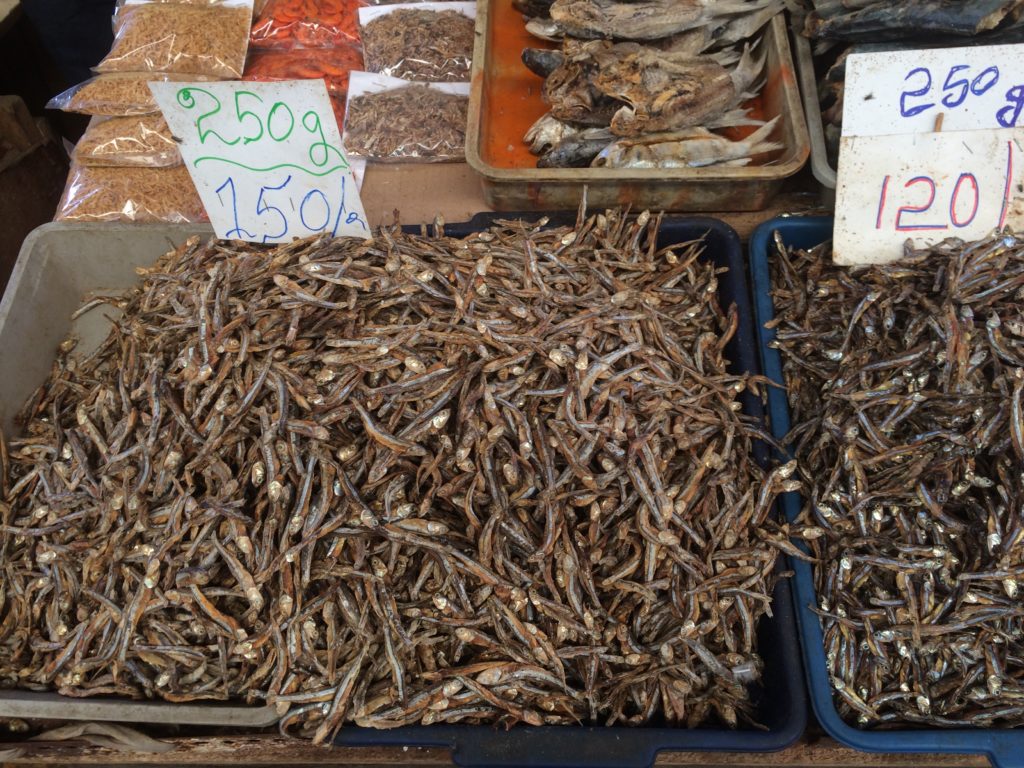
Dried fish are a lovely addition to Sri Lankan food. They are heavily salted, originally conceived out of necessity due to the lack of refrigeration. When deep fried they become crunchy. They can be served with rice.
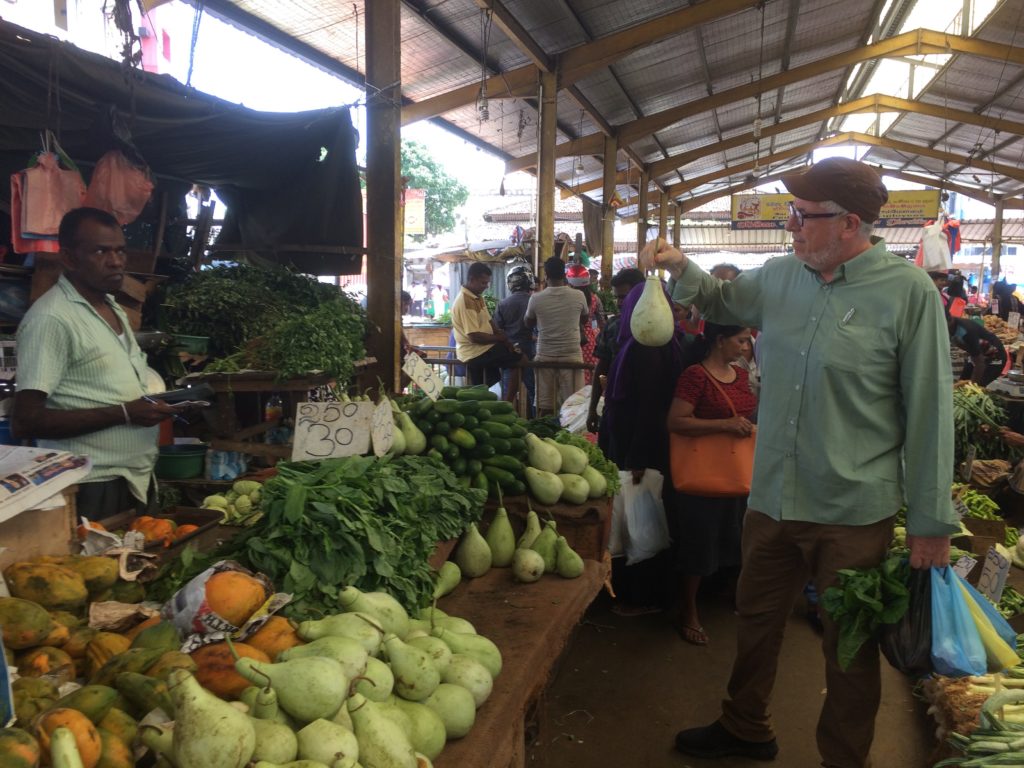
Ben is puzzled by a new vegetable we have not seen before. Some type of gourd.
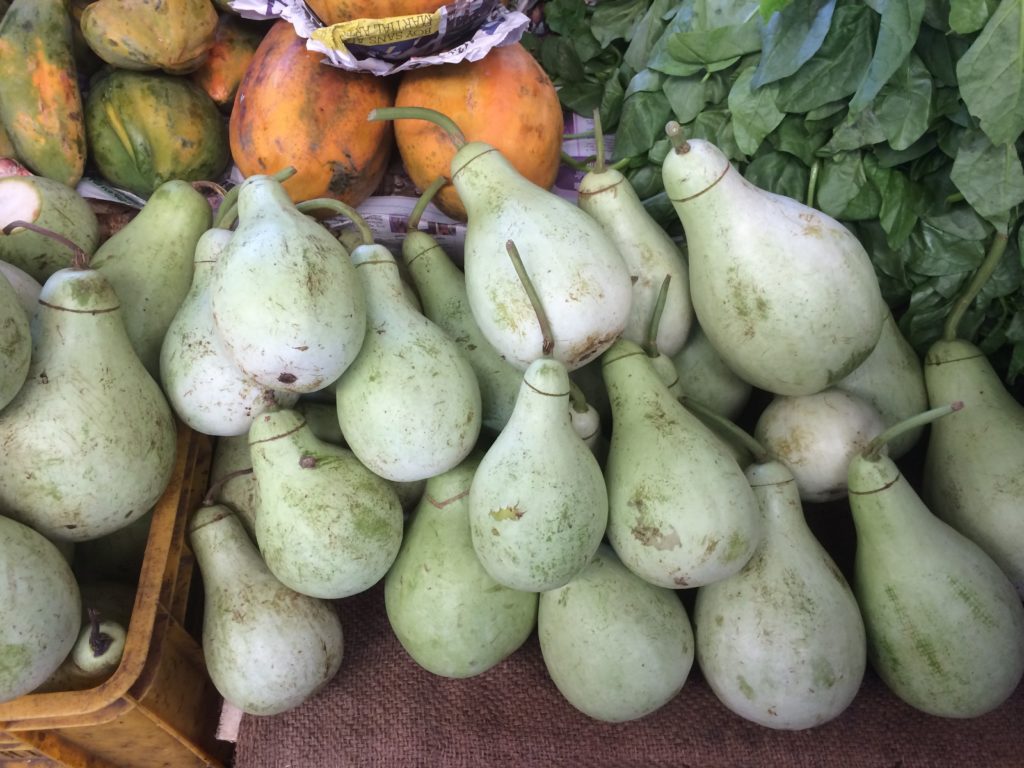
The bottle Gourd – one of these elusive veggies that we see, but have not cooked with yet..
SO, for a little inspiration, we look for the most authentic chefs – a village grandma shows how the bottle gourd is done! This video is well worth watching! At the end, you will see the unusual kind of plate that the food is served on.
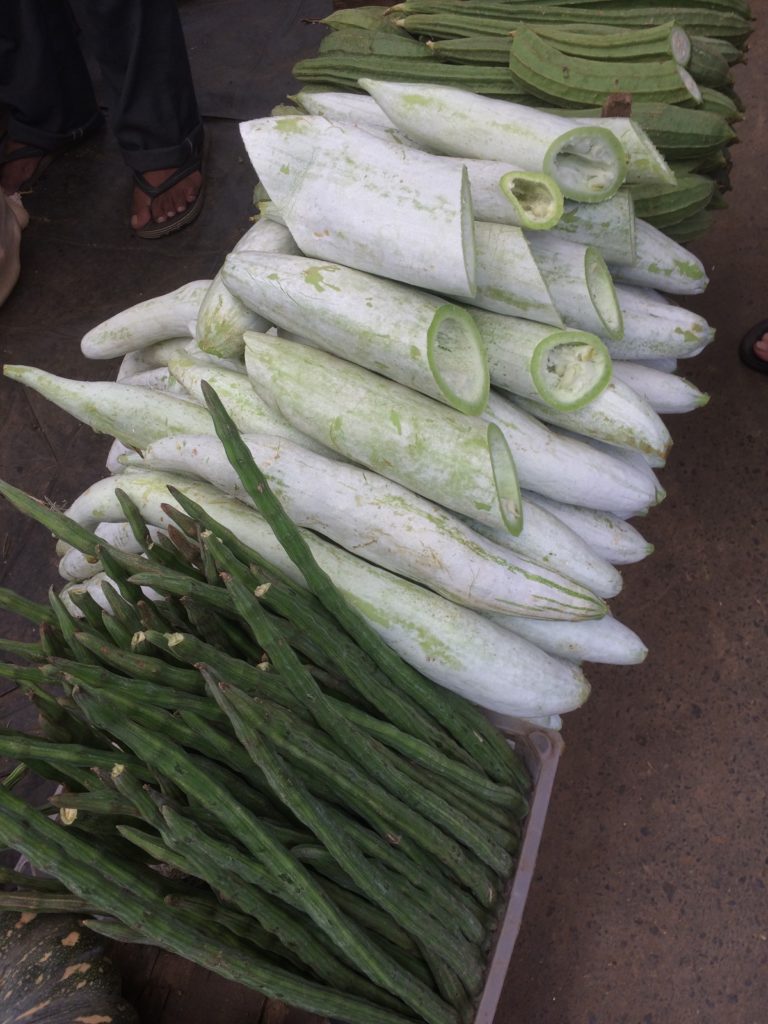
“Murunga”, also known as drumstick and two types of bitter gourds, all used in making Sri Lankan curries.
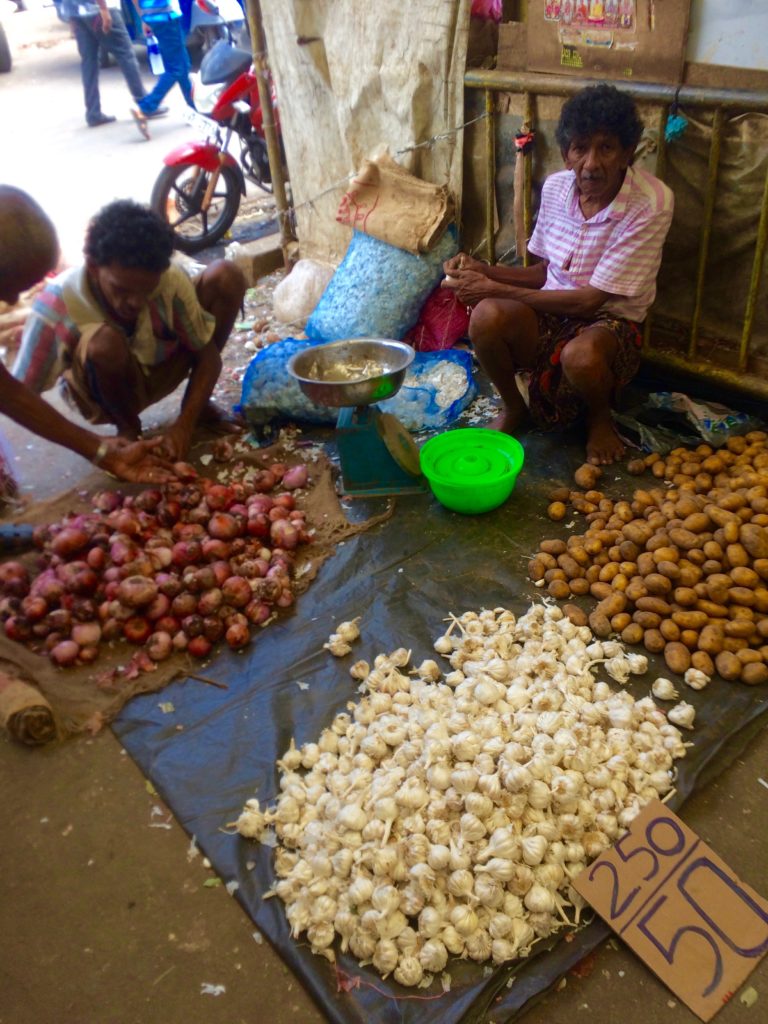
Potatoes, garlic and onions. It’s all about the curries.
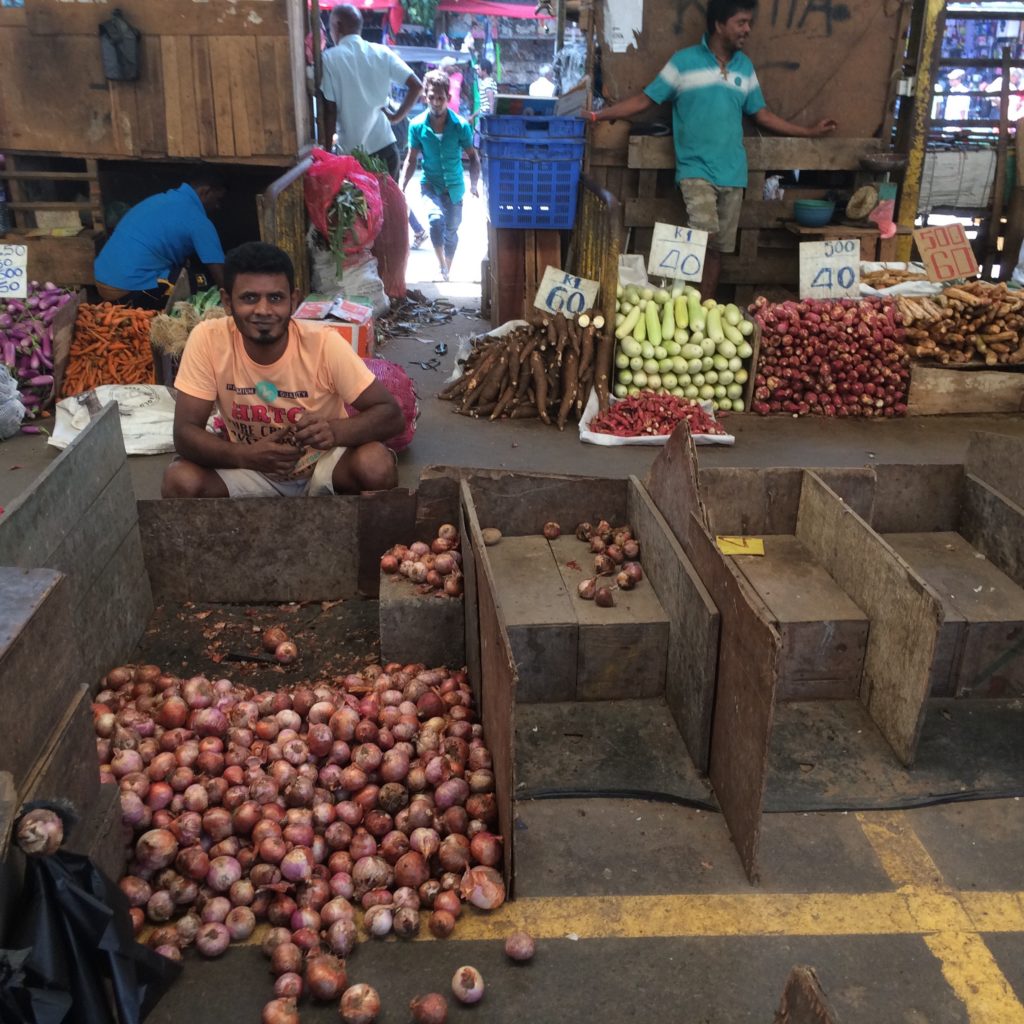
This vendor has had a good day at the market!
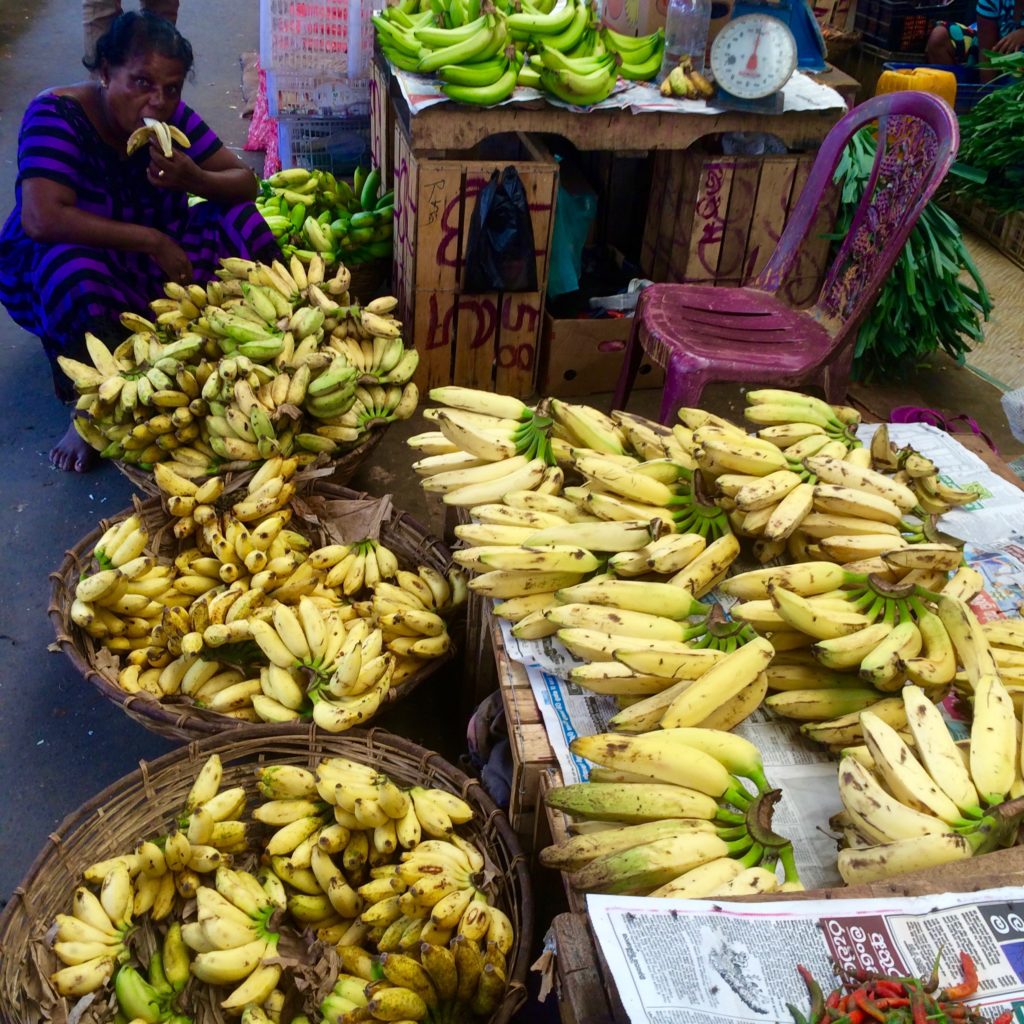
Sri Lanka boasts 29 varieties of banana, with different sizes, shapes, colors and textures. Sri Lanka’s relationship with bananas dates back as early as 340 A.D. when King Buddhadasa known as a good physician, recorded the medicinal value of the various parts of the banana tree. Factually bananas are berries ~ botanists define berries as simple fruits stemming from one flower, with one ovary.
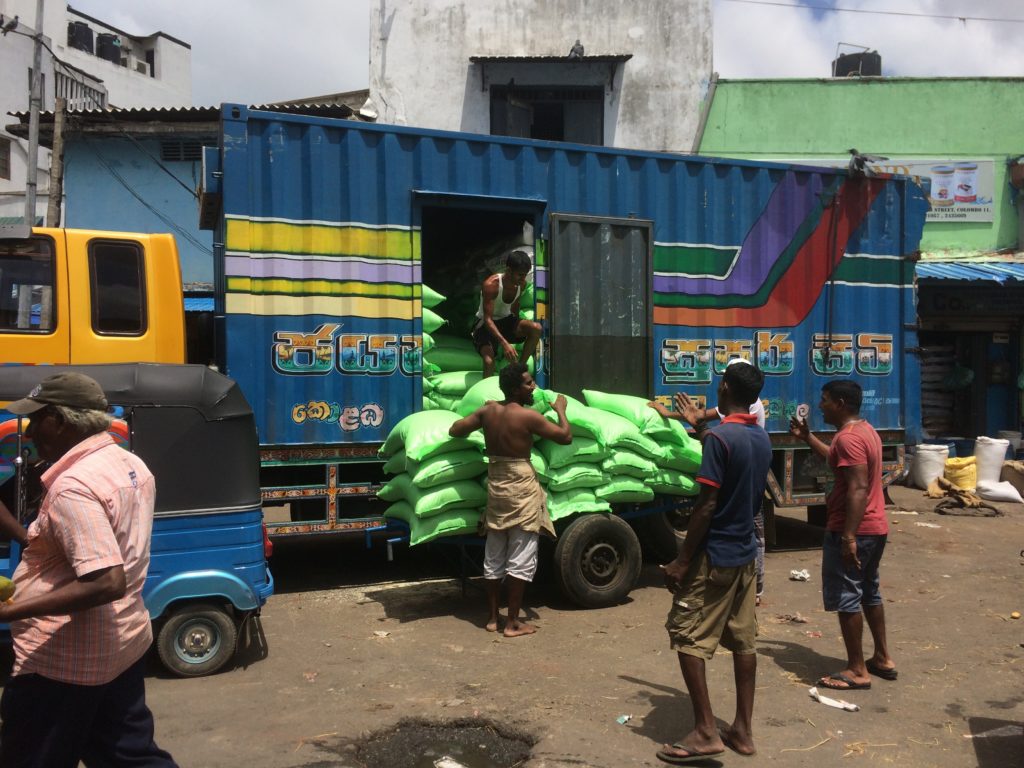
The side streets of the vast Pettah market are full of trucks delivering goods.
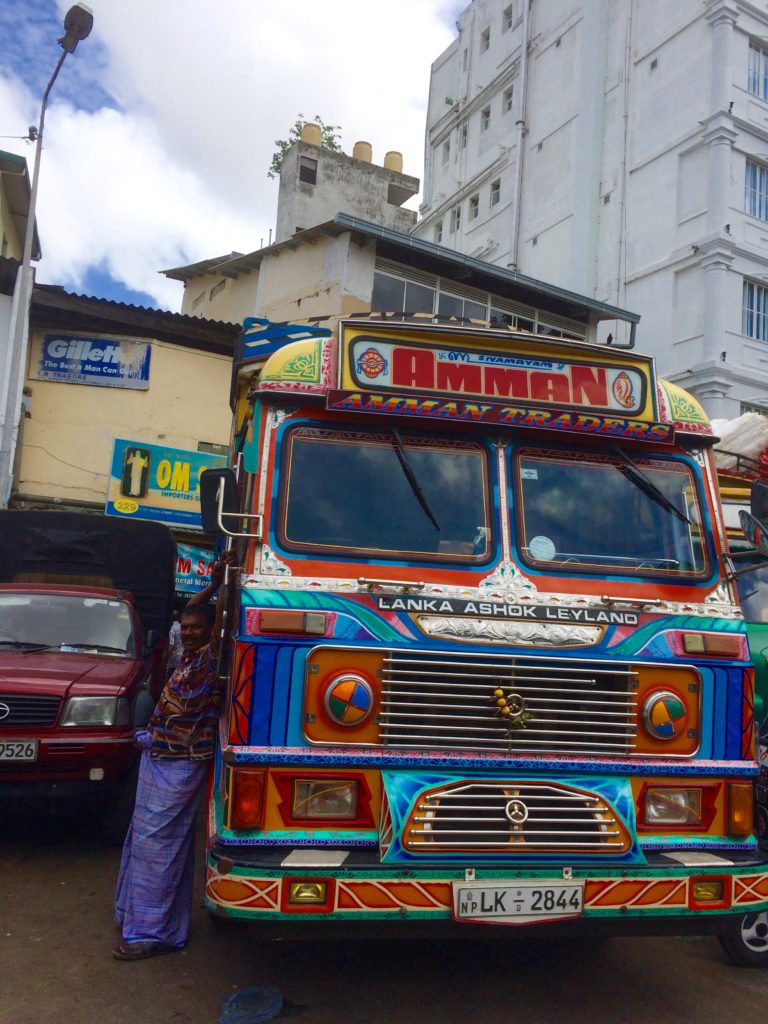
In the backstreets of the market, the symphony of colors from the fruits and vegetables and saris, is replaced by the brightly painted trucks.
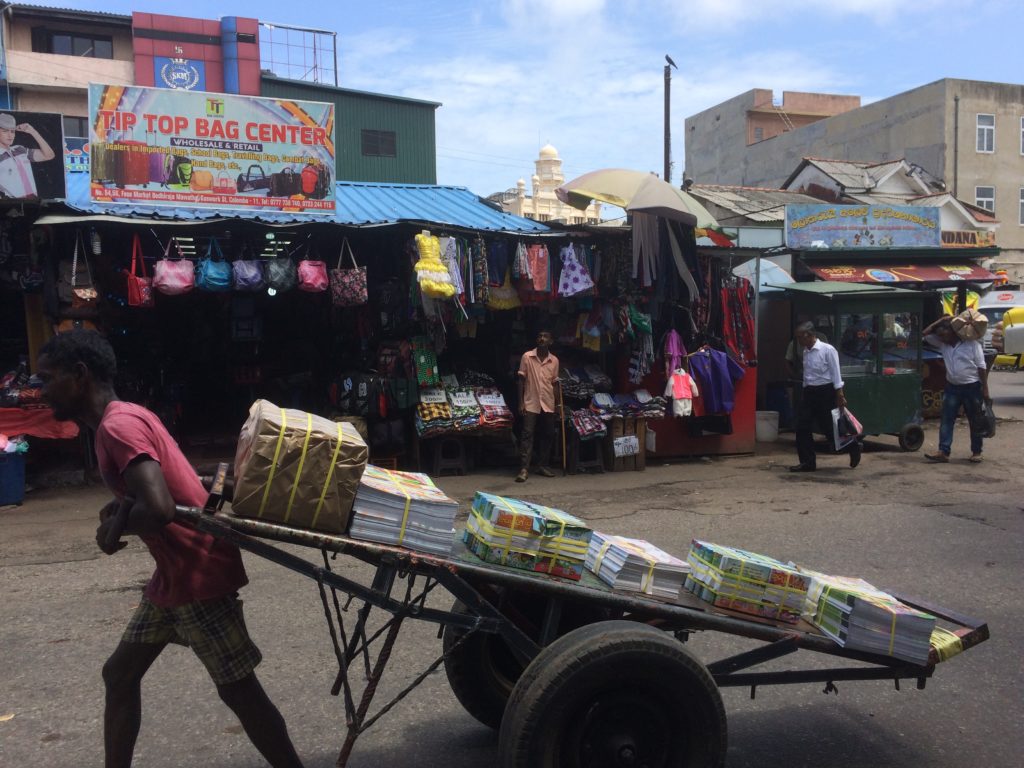
Big trucks, small trucks, man pulled wagons, everything goes… the to and fro of the delivery men is a constant.
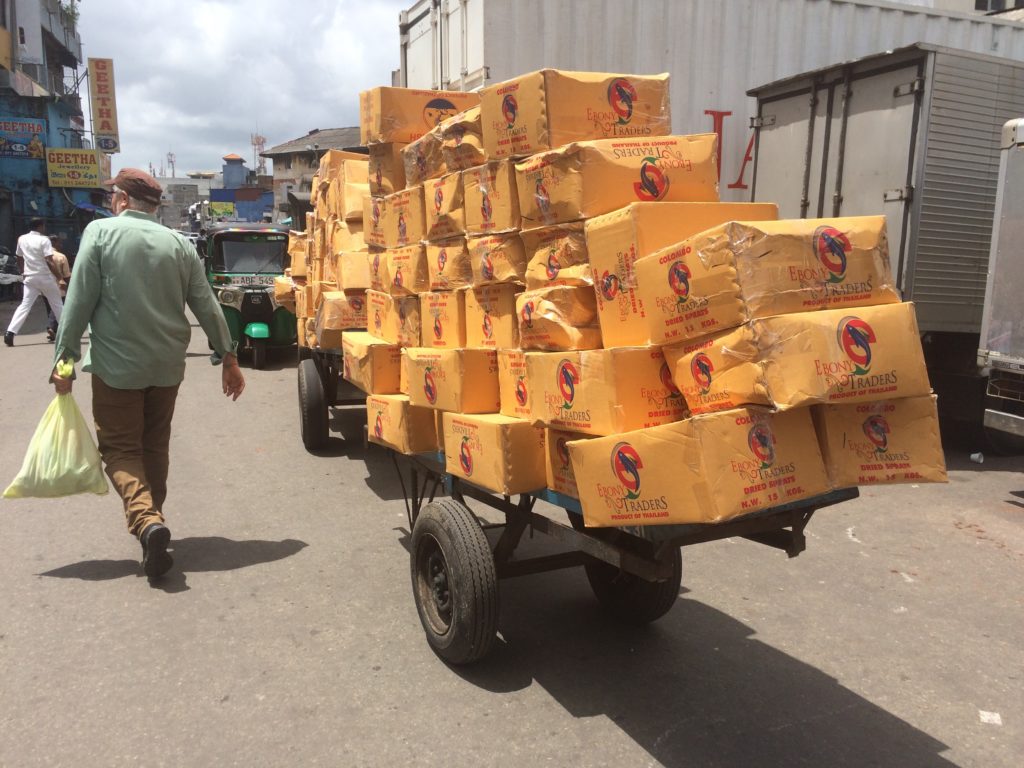
Boxes are loaded up and one has to be careful to stay out of the way of fast moving heavy objects.
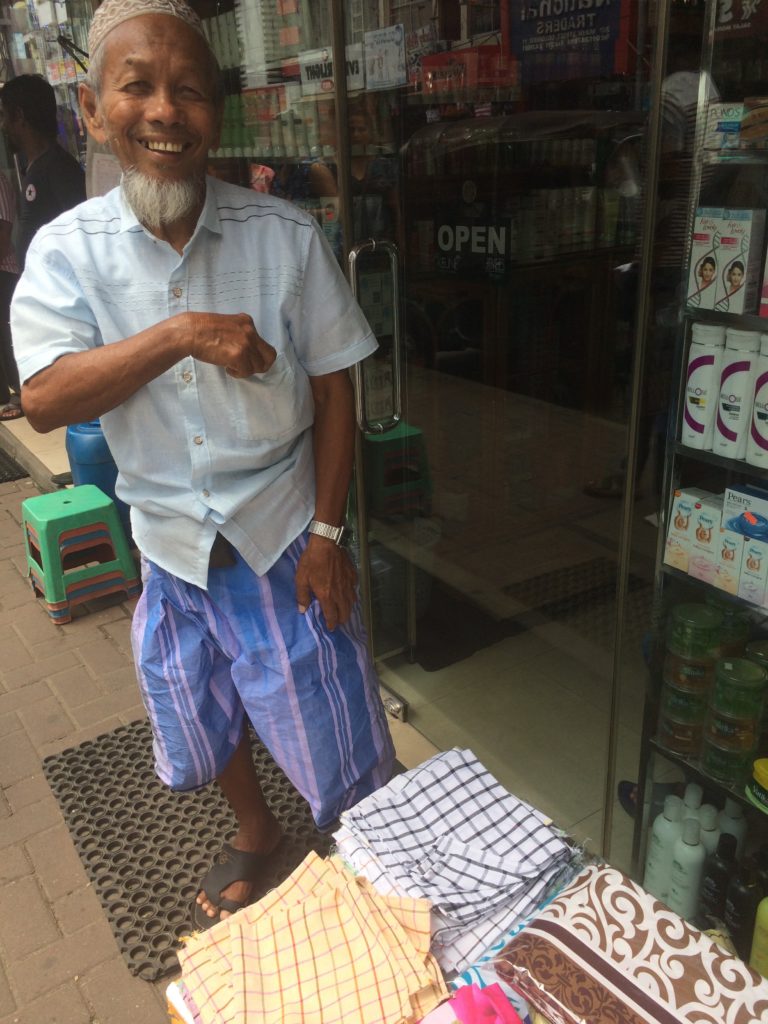
Of course at the market one can also buy clothes, toys, watches, electronics etc. Here we stop to buy a few dish clothes from this friendly Muslim man who points the way to the Red Mosque.
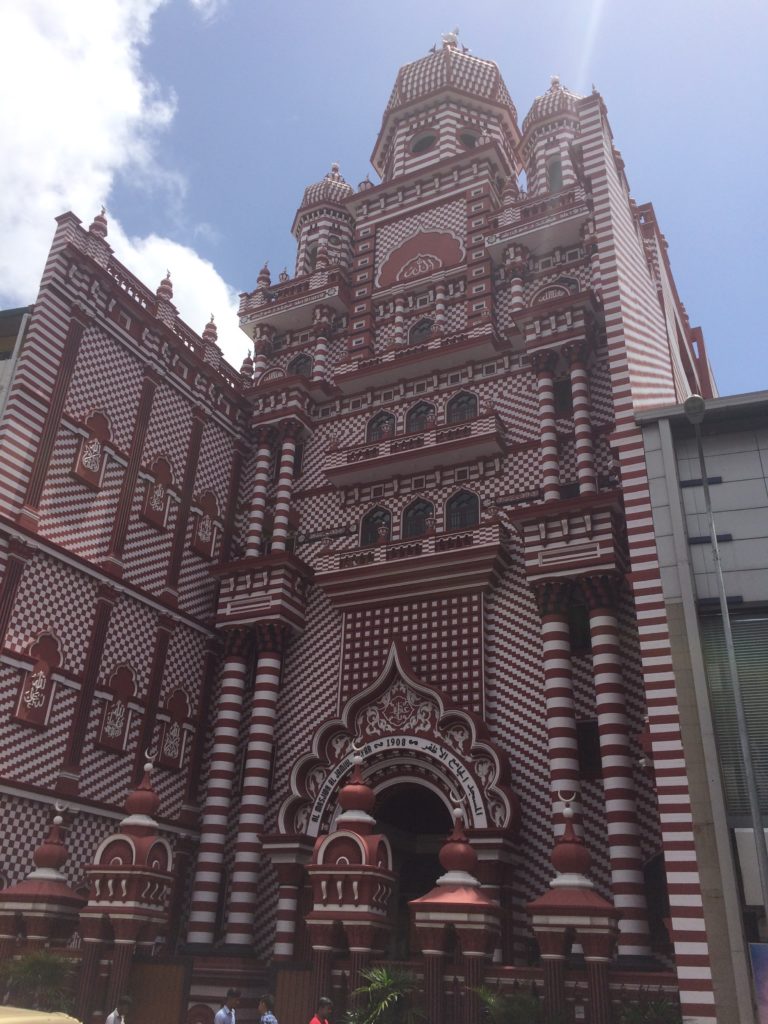
This red and white candy striped mosque is an anchor in this Pettah neighborhood market and has been for over a hundred years. (My very first date with Ben, included a mosque visit in Washington D.C.) Since then, we have visited mosques in many different countries… (France, Malaysia, Israel, Turkey, Morocco, India….)
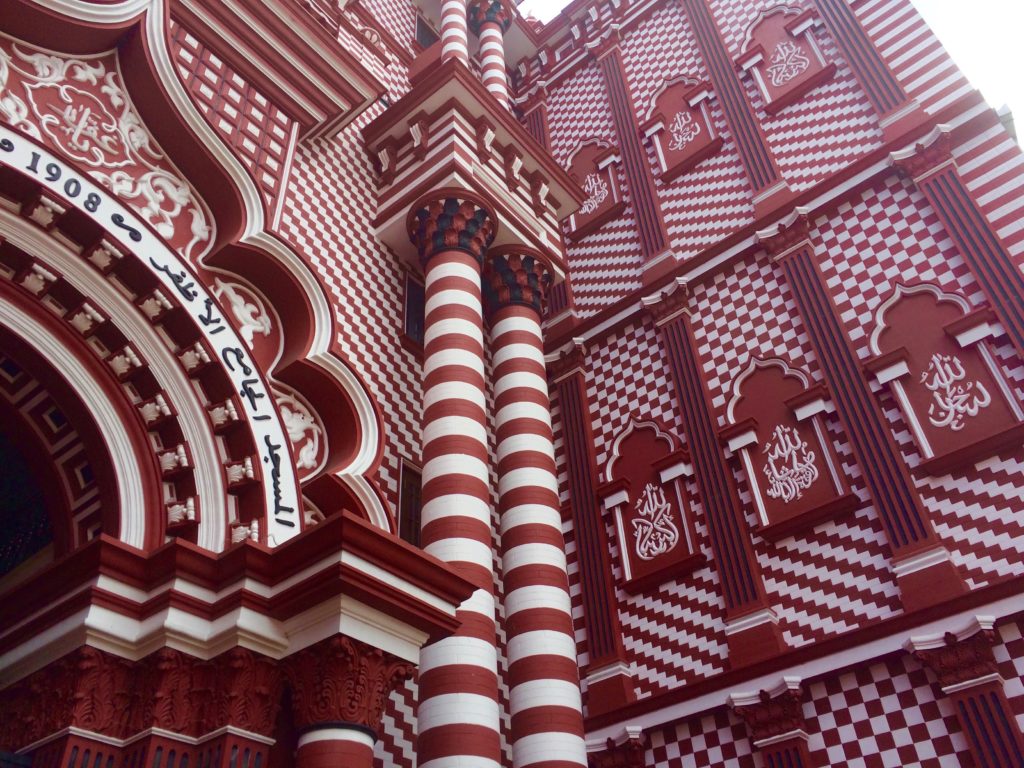
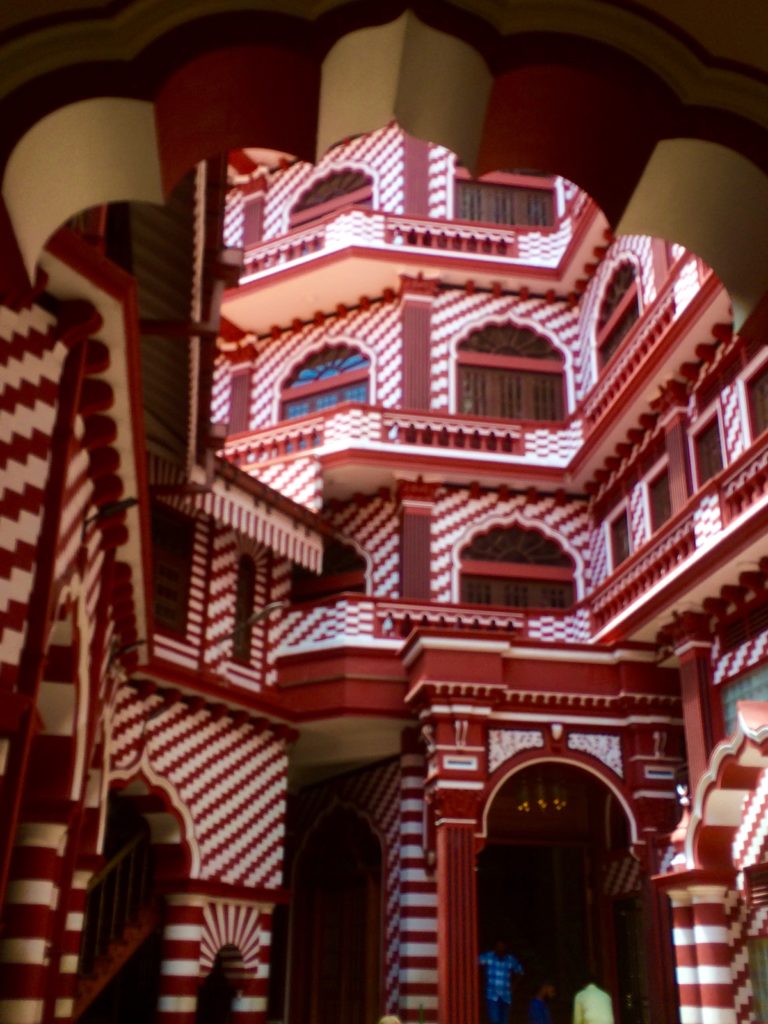

A moment of rest in the interior of the mosque where time stands still and prayer dictates time.
~
Great post Peta and Ben. As you may know from reading our blog, we’re big fans of local markets, and we try to make them a stop in every city we visit. Not only are all the local foods interesting, but the market is a big indicator of what people value in their day-to-day lives. And of course, it’s a fun opportunity to interact with the locals. Love the mosque photos as well. ~James
Thanks James, your comments are right on re the cultural indicator of what people value.
Beyond that one can also see personalities, which are fun to watch. Is there a lot of laughter and light hearted bantering or is shopping for vegetables a serious business and the mood sour and dark? Even without language, we can often pick up interesting clues. Are only women shopping, or both men and women? Do the vendors interact easily with us as foreigners or are they rather shy and hard to engage with? Is the noise level high decibel or are they soft spoken? All this allows for an early diagnostic of the behavioral traits we are likely to encounter during our travels to a new country.
Thus the market place is always a first stop for us in a new country.
Ben
Wow thanks……I feel like I just went shopping with you!
That’s funny Johnny. Nice memories of the market in Puerto Rico with you. Much smaller of course, but some good eats to be had for sure.
Peta
I loved this post, Peta.
The open air farmer’s markets are disappearing in Orange County, maybe all over the US, as real estate promoters find other, more lucrative uses for the space. When I was a kid in New Jersey, we’d stop at tiny stalls at the edge of people’s homes where we could buy tomatoes, corn, and pumpkins grown in their backyards. Once in California, I fell in love with the Los Angeles Farmer’s Market, still an icon of the city.
I’ve found a few tiny, dried looking rambutan in my local supermarket and also dragon fruit, but at such high prices, I’m hesitant to buy even one. I tried a star fruit once and found it flavorless, perhaps the victim of long travel and storage times. So, my open air market love really enjoyed this post! And that mosque – beautiful!
Thanks Sharon for your always interesting and thoughtful comments, and so glad you enjoyed this post about the market here.
It is true that there are less and less farmers markets in some areas and yet on the other hand we have experienced excellent ones in Chicago and San Francisco. It is always great to find fresh local produce being sold by the farmers. And now our son Adam has been working at a farmers market in Chicago selling salads made from his micro greens. (“Closed Loop Farms” on facebook). When we were living in Chicago recently for 1.5 years, we went to the farmers market every weekend to stock up on organic greens and fruits for the week.
About those rambutans and dragon fruits, we recommend you try and find a Chinese neighborhood if there is one anywhere near to where you live and if you go to their supermarkets you will no doubt find these fruits more easily and in better condition. Chinese customers take their fruit and vegetables very seriously.
Ben & Peta
I could not get enough of these photos today! The colors and textures and patterns were delicious-looking – in many ways – and I got a bit of an education, too. I love markets like this and seek them out as well, but I usually end up being overwhelmed by the quantities and the fact that I can’t identify so many of the items. Peta, you fit right in there in your pretty, colorful dress!
Lex thanks so much for the lovely comments! So glad you enjoyed the photos so much.
You are right, there is a bittersweet part of going to “exotic” markets, in that one finds so much produce that as Westerners we are not familiar with. What we have started doing is buying something we don’t recognize and then figuring it out later (either from friends or going online to identify it and figure out how to cook it.) We are gradually learning some of the local herbs and vegetables that are unique to Sri Lanka, but it is definitely part of the fun!
Ben & Peta
What a striking mosque, Peta & Ben! I’m astounded at the quantity of produce. Nobody’s going hungry! I don’t know that it would all be to my taste but there’s only one way to find out.
Johanna this mosque is indeed striking, both from a distance as it towers over the neighborhood, but as well, inside it is like a surreal Escher drawing come to life with all the different staircases.
You are absolutely right that the country of Sri Lanka has a rich agricultural sector and as well a vibrant fishing industry. This is not true everywhere in South East Asia but the market place is indeed stock full of bounty here.
Ben & Peta
We love markets as well and love it when we come across one in a city we’re visiting. There’s always so much to see and experience, a lot goes on at a market as you well know I’m sure. Not only can you shop, but if you pay attention you can learn so much as well.
I love the photos of the candy striped mosque. How unique!
Patti since you are currently traveling Europe you will no doubt find some beautiful open markets especially if you get to France and Italy! The main difference between European markets and those in Asia is that European markets tend to be more upscale events ~ not only more expensive but also more curated i.e everything displayed in a more “formal” manner. No fruits and veggies spilling onto the street and ground in Europe. The prices here at Pettah are extremely reasonable making produce affordable for almost all of the population.
The red candy striped mosque is reminiscent of the black and white striped churches and cathedrals in Tuscany, Italy.
Pettah – from now on you should spell your name P*e*t*t*a*h!!!!!!! It could be combined with a slightly British “twang” . . .
Love the pictures and the introduction to fruits and vegetables I never knew existed. Photos are all visually striking . . . as are you and your new name!
Ah Judith you are too funny! I like my new name…. 🙂 Actually, “Pettah” in Tamil means “outside” (as it referred to the market being outside of the fortress of Colombo). And as I am an outsider in this land, I guess it does fit. But on the other hand, my name Peta also means “map” in Indonesia as we discovered every time there was a billboard with a map and my name on it, and that fits too!
Thanks for the compliment.
Peta aka P*e*t*t*a*h !
My husband and I love visiting local markets when we travel. If we are in one place for a while, we like to establish a relationship with several of the vendors – that way we learn can learn more about their produce/product and we always enjoy a familiar smile.
The mosque is amazing! Is it painted that way or are those tiles?
Janis we too enjoy going back to the same vendors when possible. In our area of Galle, we have a few small tiny stalls on the street fairly close to where we live that we frequent and are now regulars. Even though we do not have language, the familiarity is always a plus, as you say.
Great question re the mosque. It is not paint, but rather, two different colored bricks.
Ben & Peta
What a fabulous market! Like you we love to explore the local markets.
Alison
The market place is always the first place we go in a new country or city, if there is one, we find it. We have so many great memories of market places in Viet Nam, Laos, Hong Kong, Cambodia, India, Spain, Turkey…. So many markets to visit, so little time!
Thanks for stopping by Alison.
Ben & Peta
I paused at each photo taking in the colors, your description and if I tried very hard, the aromas from the market. Absolutely tantalizing even to wander with you let alone be there ourselves. Gorgeous photos and that mosque! Oh my that is incredible.
Sue that’s great! So happy to be able to share the market place with you it such a vibrant place. We had a similar feeling when viewing the video that is inserted in the blog… one can almost smell the food while it’s cooking!
Thanks for the compliments on the photos!
Ben & Peta
Well, I think I recognized garlic, potatoes, and carrots…
How long has it taken you to learn about all this produce?
Dave, it is definitely a work in progress. Each time we go to a market we try to remember the Sinhalese name or take a photo of something unidentifiable to us. Then we find out the name of the vegetable and how it is used in Sri Lanka. The bottle gourd was the one veggie we wanted to better understand, thus the video inserted, on how it is prepared by village women.
Ben & Peta
Ahh.. how I love those markets.. I’m sure the scents from Pettah are similar to the ones I smell wafting over Ubud’s market too. Funny to see so many of the same produce; rambutan and mangosteen (yummmm), pumpkins, mountains of lime!
And what a stunning marvel, that mosque is.
Yet another fabulous up-close-and-personal tour, full of a whole spectrum of sights and smells.
Amit actually there is a very unique smell we think to Ubud’s market and Ubud in general. The sweet aroma or the rice offerings and incense in the air is for us a distinct smell reference. But yes, there is a lot of commonality in produce, especially with the fruits. The quantity of produce in each stall is also bigger here, at this Pettah market in particular. Conversely, there are no flowers for sale to be seen anywhere and we miss the beautiful blossoms that are sold for offerings in the Ubud market.
Thanks for stopping by to read us and commenting.
Ben & Peta
We too love open air markets in foreign countries and so often I hear myself asking over and over, “What’s this?” and “What’s that?”
Your video was fascinating, especially the amazingly sharp kitchen implement used to cut the vegetables that seemed almost like a type of fixed machete. I enjoyed your many brightly colored photos once again from the fruits and vegetables to the magnificent Red Mosque.
My favorite photo was of the beautifully painted and elaborately patterned truck which reminded me of the chicken buses in Guatemala. Sri Lanka continues to tease and tantalize me in your posts, Peta and Ben.
Another great read! Anita
Yay, thanks for commenting on the video Anita. We found it absolutely mesmerizing to watch the cutting and cooking process. Interestingly enough this village grandma has a whole series of cooking videos that introduce local produce. They are fascinating to watch as she clearly has made all these foods many many times over. Very interesting how she does not chop on a chopping board, even the smallest veggies, are all done on that “in the air machete”!
Great observation on the parallel with the Guatemala buses. We had not made that connection but you are absolutely right. Indonesia and Haiti also have super cool colorfully painted buses. As Ben is color blind, the vivid bright colors of these buses work well to get him out of the sepia range of colors that is often his norm.
Thanks Anita for your always thoughtful comments!
Peta
Beautiful post! I haven’t heard of half of these vegetables, but I think that’s what makes all this fascinating… We go through limes like crazy here in Egypt, too.
Thanks Dee. We are still learning about all the local herbs and vegetables, as there is quite a large variety that are specific to Sri Lanka. Many of them are seen as having Ayurvedic medicinal value. But we do seem to know all the fruits now…
Egypt! That’s a current I look forward to visiting one day and going to it’s markets.
Peta
Once again I am blissfully lulled into the Sri Lankan lifestyle, this time visiting street markets, one of my favorite things to do. Thanks so much, Peta, for the beautiful descriptions, photos, and captions.
I love your attention to detail, with the woman sampling rambutan and her bulging cheek, the vendors and the wares, the foods and their properties. I have memories of a happy day eating a big bag of rambutan in Hawaii; but I have never seen or heard anywhere of mangosteen, something to look forward to.
I loved being on the scene, with the saris and colors and different fruits, vegetables, and fish; have never seen pineapple displayed this way, fascinating. And then being behind the scene, with the colorful trucks and carts, the mosque.
A true joy, thank you.
Jet thank YOU for your thoughtful and enthusiastic comments. So glad that you enjoyed this post so much and felt as though you were “on the scene” with us.
When you do taste mangosteen, you will wonder why you waited so long 🙂 I think it is one of my very favorite fruits of all time. If you have had the Latin American large fleshy sweet white “guanabana”? the mangosteen is something of a cross between a guanabana, and a lychee with the segmentation of an orange.
Peta
We too love markets and there are plenty here in Spain. Your pictures are wonderful and really give an idea of the flavour of the Sri Lankan markets.
Darlene, we spent about six weeks in Spain, three of which were in Granada, and we hit the market there whenever it was open. It had pretty good fresh produce as we recall. The most memorable market was probably the covered one, in Barcelona!
Peta
I love local markets. It’s great to feel the buzz and get a slice of the local life. And you can always get the best produce at competitive rates. 🙂 Thanks for sharing another fascinating snippet of your life.
Thanks Cheryl. It’s true, there is nothing quite like the buzz of energy at markets, with locals humming about and engaging in a centuries old practice of going to market to buy their food. This market has other huge sections too, where one can buy all sorts of things from clothes to toys, electronics, watches etc.
Ben
Mmm, I could smell the aromas in this post! Except the dried fish, I skipped quickly past that. Loved the read and white mosque too.
Funnily enough Anabel, the dried fish had very little smell, I guess because of it being sun dried and salted. The fish market though near us, well, that’s another story! (Perhaps we will do a different post on that market as it is quite a scene, smells and all.)
Peta
Peta your explanations are as colorful as the photos. Thank you so much for sharing your adventure. Can’t wait to meet you and see this all for ourselves in Feb.
Thanks Debbie! So glad you enjoyed this post. Thanks for reading us and commenting. Feel free to email me anytime for suggestions for your trip or to answer any questions you might have. Exciting!
Peta
It looks like mangosteen season in Sri Lanka is about the same time with Indonesia. It’s one of my favorite fruits ever, so much so there was a time when I finished 2 kg of mangosteen in less than half an hour. Our stay in Kandy two years ago was a revelation as I was introduced to a wide array of Sri Lankan dishes I didn’t try on my first visit to the country back in 2012. Gotukola sambol, luunu sambol, woodapple juice, umbalakada, oh now I really miss Sri Lankan food!
The man from whom you bought some dish cloths looks Southeast Asian — I would be surprised if he’s actually Indonesian since Sri Lanka is not usually a place Indonesians would think of going to start a business.
Such lovely photos, Peta! And they remind me to eat more healthily.
Haha Bama, that IS a lot of mangosteen to eat at one time. But they are definitely addictive they are so delicious.
Sri Lanka definitely has a wide diversity of distinctive curries and sambals! Unfortunately I am allergic to onions which are used in almost every dish. The only way I get to eat those sambols and curries is when they are made especially for me, sans onions and luckily, there have been a few places that have happily obliged.
Thanks for the compliment on the photos!
Peta
Yet another gorgeous post Peta! The veggies look so fresh and inviting -its almost enough to convince me not to eat my para-blogging Snickers snack (almost) ;).
In all seriousness though, I know what you mean. Shopping at open air markets is an immersive experience, and I do enjoy hand-picking fresh meat/fruit/veggies from vendors that I can (try) to have a conversation with.
Actually, now that I think about it, open air markets are an ideal place to try to hone familiarity with foreign languages. Don’t you think?
And loved the “candy cane” mosque.
Thanks Gabe!
Yes shopping at open air markets is a very “hands on”, interactive experience. It is definitely a good place to get language exposure and hopefully pick up a few key words or phrases….
Sri Lanka is one of the few countries where we have NOT picked up much language neither Sinhalese nor Tamil, as those locals that can speak English will use English exclusively with foreigners and many have no English whatsover, in which case body language and gesturing is usually the best “language” to get by with.
That mosque is quite spectacular.
Peta
I absolutely adore food markets, this one really is “the mother of all markets”, incredible variety, fruit and vegetables I have not even heard of before….would love to try them all. I remember how amazing were the food markets in Thailand, colours, smell and flavours galore…an assault to all your senses…in a good way. I just had dinner, but now feeling very hungry again 🙂
Gilda we spent a good two hours at the market, searching for the cashew and almond stall, which we eventually found way across from where we had started. Having a destination to find was great as it took us deep into the market and way behind it, through all the different streets that we might not have seen otherwise!
It’s true though that markets have a way of making one hungry! The markets in Thailand were incredible. Especially a huge one on Sunday nights in Chiang Mai with all sorts of treats in every direction!
Peta
Makes me hungry and homesick 🙂 so gorgeous!
We miss you here Tes. Is there a market near where you are now?
Thanks for reading and commenting.
Peta
Oh my! I would go insane in a market like this one!! I’d be tempted to buy oodles of everything just to try! … and the fruit! I can just imagine how wonderful it is when so fresh off the tree. Tropical fruits purchased here are a sad imitation of the *real* thing because they are picked and shipped long before they are ripe.
Thanks for taking us on this culinary tour. This was such a visual treat. I LOVED it!
As I read this, Ben is contemplating tackling a loofa, which I always thought of as a sponge like scrubber, but in fact is first and foremost an edible vegetable. It is about 2 feet long, the circumference of a cucumber and one of those exotic vegetables that we decided to buy and find out how to cook, Sri Lankan style. The loofa vegetable is used in a coconut curry and supposed to be quite sweet. We shall see.
The tropical fruits are great. We have a few jackfruit trees on the property and it has been great getting an introduction to this fruit, “fresh off the tree”. But we do have to compete with the monkeys who love this fruit too and because they get so big, one jackfruit can feed a whole family of monkeys for about 4 days!
Joanne thanks for your enthusiastic positive feedback. So satisfying to know that our posts are being appreciated and enjoyed!
Peta
What a feast for the eyes (and palate) you’ve presented. I wanted to transport myself to those colorful, chaotic stalls and buy a handful of every fruit and vegetable you photographed (drooling over those pineapples spilling onto the pavement). I do understand why markets like this are disappearing, but I love them in all their jumbled “unsanitary” state for eye-opening perspectives into the places I visit.
I have adored this virtual trip to your market and look forward to visiting there in person next year (and a visit to the candy cane mosque will be icing on the cake!) The colors and the smiles were just delicious. We share your love of open air markets as we travel under sail. The Captain for the fresh treats (he does all the cooking on Amandla) and me for all that eye (lens) candy. Market visits always satisfy my addiction to color. Big hug from Siem Reap
Lisa it is good to read you! So glad you enjoyed this trip to our main market so much. Oh how fun to sail to different market locations in the world and have someone do the cooking for you!! When do you anticipate docking in Sri Lanka?
“addiction to color”.. didn’t know it was an addiction :), but yes, we are addicts too!
Enjoy Siem Reap and try to go to the butterfly farm near there which we visited. Once you have had your happy pizza, of course!
Peta & Ben
That is indeed the mother of all markets! And, you open with my favourite fruit of all time…mangosteens. I had them on my first visit to Thailand and could not get over the fabulous flavour. How fun to explore this market!!!
I gasped when I saw the photos of the mosque. I have only seen another red/white candy stripe mosque in Cordoba. Wow, it really makes a statement.
Great post!
Yay, another mangosteen lover! I am trying to decide if I love mangosteens or lychees the most. Probably mangosteen as it does have the most incredible and unusual flavor. But lychees fresh on a branch… mmmmhmm! Yum.
Cordoba! Yes you are right. We had not made the connection between this mosque and the one there. But we have been in that mosque as well, it is quite beautiful with all the arches.
Thanks for the lovely compliments on the post.
Peta & Ben
What a feast for the senses! We also love open air markets. There are some wonderful farmers’ markets in the U.S., especially in the Pacific Northwest, but that market is indeed the mother of all markets. Such a riot of color and exotic offerings!
I had no idea that there are 29 varieties of bananas. And I’m curious — what does rambutan taste like? This post makes me hungry. :-))
The candy striped mosque is fabulous, as well.
Laurel, there are 29 varieties of bananas just in Sri Lanka alone, but globally apparently there are many more. The ones that come to mind instantly as truly different, are a tiny lemon banana (about the length of a middle finger) and as the name suggests, it tastes very citrusy. And the larger butter banana which has a milky kind of taste.
Rambutan tastes similar to a lychee if you have had one of those? but not as juicy. It has less flesh and a larger pit than a lychee. Of course if you haven’t had a lychee, this comparison doesn’t really help.
When we first saw the striped mosque while walking down the street, it was quite a surprise, seeing as the street is an intense shopping area with lots of clustered smaller buildings. So it really pops out!
Peta & Ben
Another veritable feast of sights and sounds (yes, with your photos, I feel like I could HEAR the open market) and new tastes to imagine. Your photos are just incredible.
I love the idea of open markets – they are becoming more ‘the thing’ here in the U.S. also. We used to love visiting the one at the Ferry Building in San Francisco — until it got so popular it became too crowded. Boston has an open farmer’s market that is becoming popular also, but even sweeter are the ones we go to at smaller ‘villages’ in New England. I love seeing the local farmers get attention – finally.
THANK YOU for bringing your part of the world to us.
Pamela thanks for such lovely compliments on the blog and the photography!
Yes smaller markets in the U.S. are the ones to find. We found wonderful ones in neighborhoods of San Francisco and Chicago. It is definitely important to support local organic farmers for the amazing work they do to bring healthy produce to the public!
Delighted to say, that our youngest son, who was formerly a chef, has now joined the ranks of small organic farmers in the U.S. He is based in Chicago and sells micro greens to restaurants and works at local markets in Chicago selling his produce and amazing kickass salads!
Peta
Such markets are still popular in Asia, I have seen many of them in Mumbai not as big as this one!! But yes, there are markets segregated for flowers, fishes, veggies and there is still a huge population in Mumbai that shops from such markets 🙂
Must say, your pictures give reader a virtual journey! I really liked the Jalapeno art.
Cheers, Charu
Charu glad to read that you enjoyed the virtual journey to the Colombo market with us. Ahhh Mumbai, we were there for 3 weeks and we stayed at the Hari Krishna center which has a reasonably priced and nice hotel, which was quite a unique experience. We went to the small markets in the area to get fruit but never ventured much further than our immediate neighborhood which had plenty to keep us occupied. Hope you come back and read us a couple of entries from now when we will dedicate a post to markets in India which we experienced and particularly loved!
Peta & Ben
Enjoyed the tour of the market – thanks Peta. The mosque was really grand.
Glad you enjoyed it Dahlia. Take a look at the series we just did on Asian markets. No doubt you will enjoy that too. The last of those, the fourth one, will be about India.
Peta
I used to come to Pettah every single Monday for a year when I had a home bakery in Sri Lanka. Now it’s more of a hang around, take some pictures, eat some street food kinda place for me. Going there today 🙂
Hi Yulia, thanks for stopping by to read Green Global Trek. We don’t get to Pettah market very often, but when we do it is definitely always worth it. Enjoy!
Peta & Ben